The Wing of History Air Museum in Gilroy, California, is a nonprofit organization dedicated to preserving and restoring antique aircraft since 1974. The museum features over 100 historic planes, including replicas and original models by renowned designers like Burt Rutan and Volmer Jensen, with many displays labeled with historical notes on their manufacture and significance. Volunteers actively restore and maintain the collection, which also includes a library and prop shop.
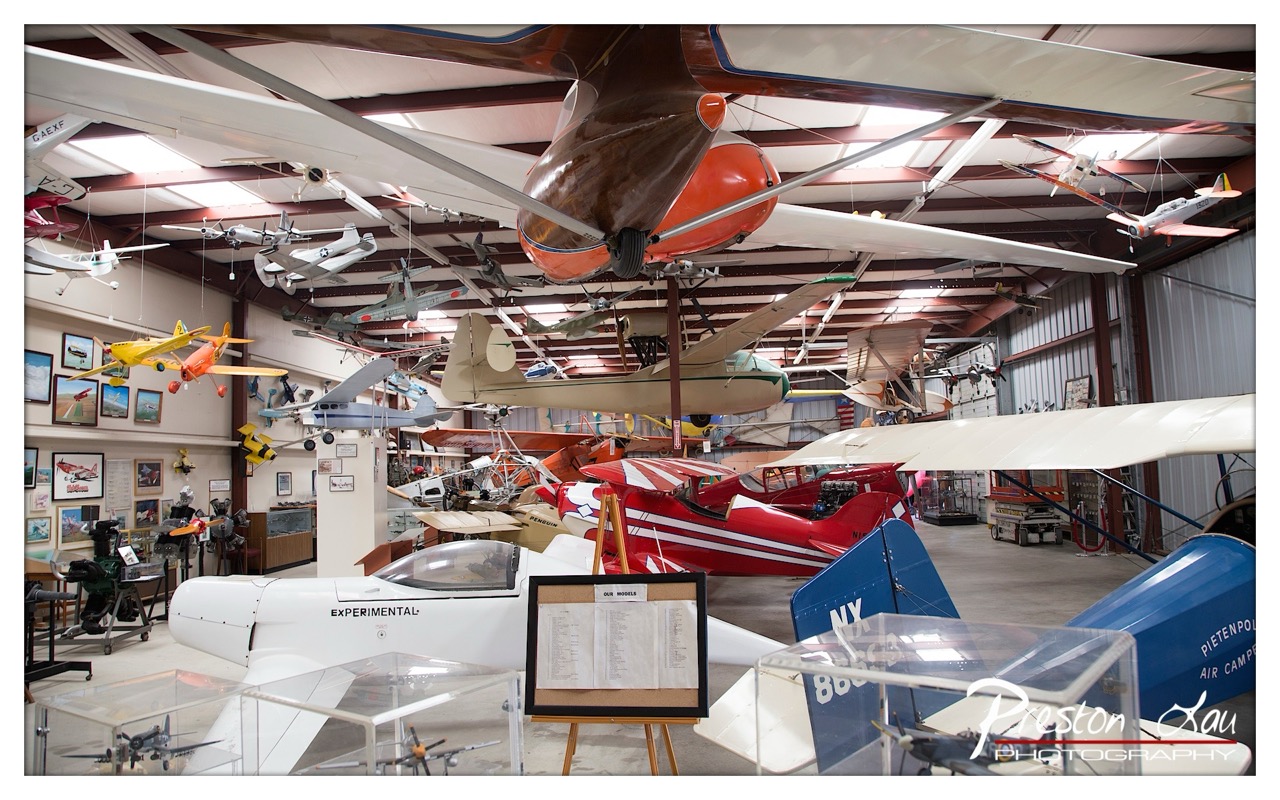

Hangar Havoc: An Aviation Overload
Subject: 8/10
Welcome to what appears to be the world's busiest aircraft hangar, or perhaps a vintage plane collector's fever dream. The subject, a massive collection of aircraft ranging from tiny models to full-sized planes crammed into a single space, is inherently fascinating (Subject: 8/10). It's a nostalgic overload, giving off a strong vibe of passionate preservation and maybe just a *touch* of hoarding tendencies. Planes are suspended from the ceiling like metallic mobiles and parked wing-to-wing on the floor, creating a dense, almost overwhelming visual tapestry of aviation history. It feels less like a curated museum and more like everything was just brought inside before a big storm, with highlights including a prominent red biplane, a white experimental craft, and the tail of a blue Pietenpol Air Camper.
From a photographic standpoint, this scene presents a classic challenge: how do you capture chaos? The composition here leans into it, presenting an eye-popping array from floor to ceiling, but it ends up feeling cluttered and confusing, like a visual traffic jam. The underside of the large brown and orange plane dominates the foreground, obscuring much of the detail behind it – a bold choice, or perhaps just the only angle available without bumping into something precious. The lighting is typical for a hangar – a mix of bright spots from overhead and shadow, creating uneven exposure and blown-out highlights, which doesn't help untangle the visual mess. While the sheer volume of cool planes is evident, the photo struggles to give any one element room to breathe. It's a snapshot that says "Wow, look at all this stuff!" rather than offering a clear view of any specific piece, proving that sometimes, capturing the essence of a packed space means embracing the glorious, overwhelming jumble, even if it means giving your viewer visual whiplash.
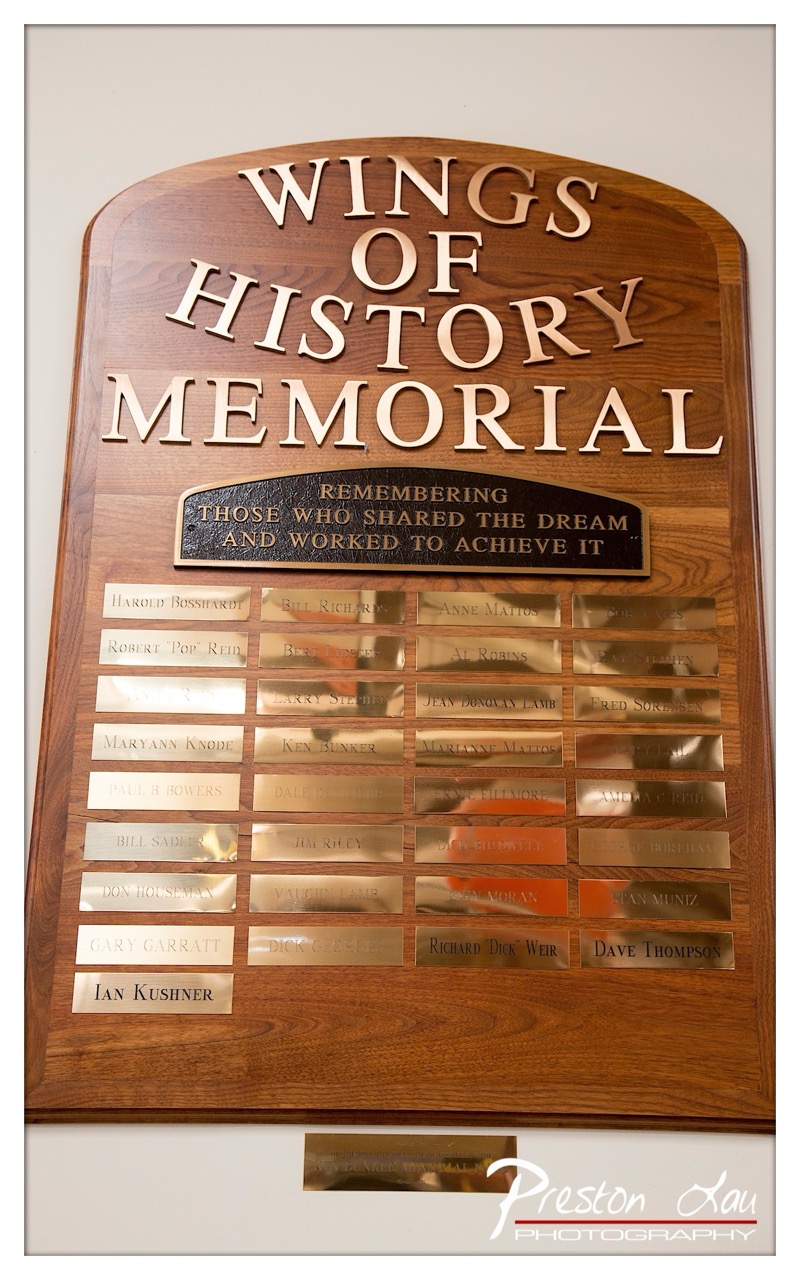

Wings of Glare: A Memorial Plaque's Shiny Predicament
Rating: 6/10
This image showcases a handsome wooden memorial plaque, its dark grain providing a solid foundation for the metallic tributes it holds. The prominent, raised brass letters proudly declare "WINGS OF HISTORY MEMORIAL," setting the stage for remembrance. Below, a darker plate reinforces the sentiment: "REMEMBERING THOSE WHO SHARED THE DREAM AND WORKED TO ACHIEVE IT." The bulk of the plaque is filled with rows and columns of smaller, polished brass or gold nameplates, each engraved with an individual's name. The overall presentation feels formal and respectful, embodying the purpose of honoring a group who contributed to a shared vision, likely related to aviation or a historical endeavor based on the "Wings of History" title. The contrast between the warm wood and the gleaming metal creates a classic, enduring look.
From a photographic standpoint, the composition is straightforward, centering the plaque and capturing its full detail. The simple, light background wall ensures the focus remains squarely on the memorial. However, the real story here is the lighting – or rather, the battle against it. The highly reflective nature of the nameplates, while attractive in person, has unfortunately led to significant glare hotspots in the photograph. Several names are partially or entirely obscured by bright reflections, proving that light can be a photographer's best friend or most dazzling enemy. It's a classic challenge when shooting polished surfaces, and here, the light source appears to be hitting the plates at an angle that maximizes reflection, making the primary purpose of documenting the names rather difficult. A diffuser, polarising filter, or even just a slight change in camera angle or lighting setup could have tamed these unruly reflections and allowed the names of these deserving individuals to shine, rather than just the light itself. The photographer's watermark modestly sits at the bottom, overseeing the shiny chaos.
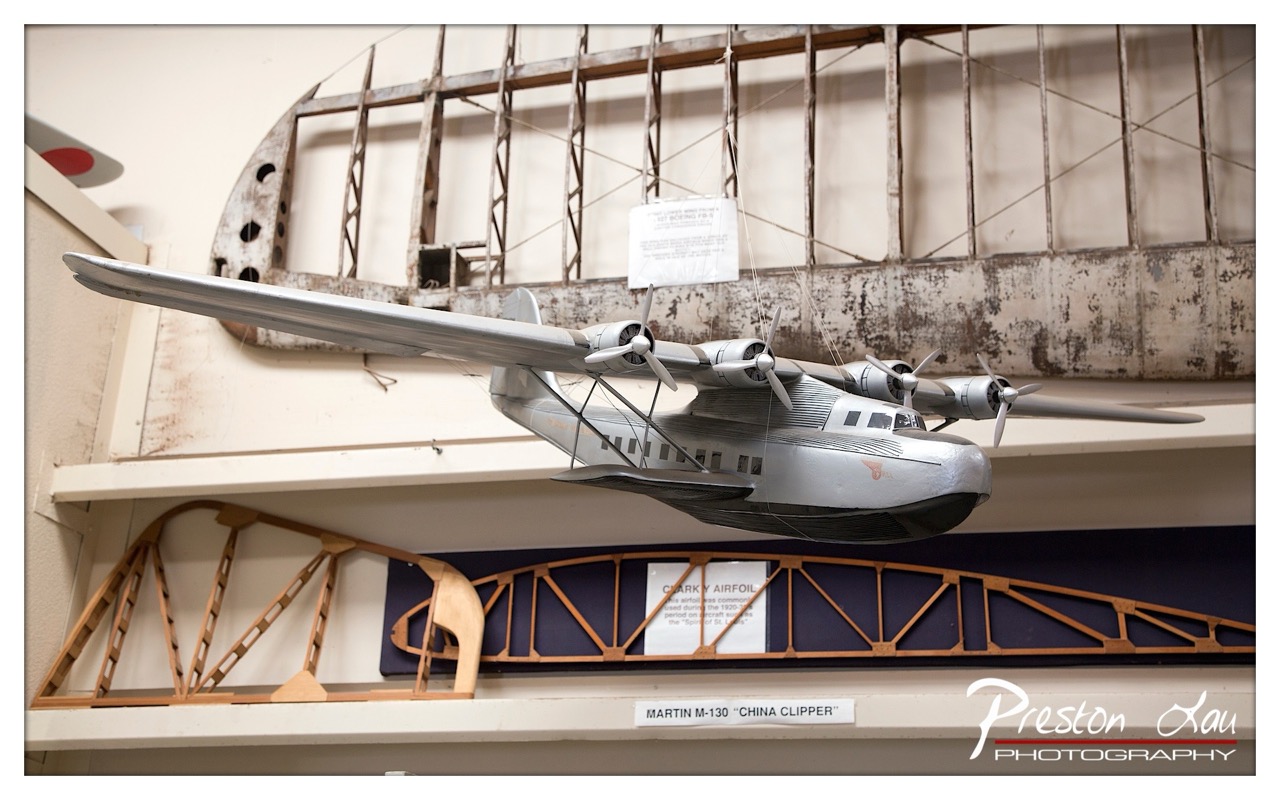

Museum Piece Ready for Takeoff
Rating: 8/10
Suspended mid-flight (or perhaps just hanging from the ceiling), this beautiful model of the Martin M-130 "China Clipper" takes center stage, a silver icon of early transpacific travel. Below it, a wooden structural model of a wing rib adds context, while a massive, skeletal framework looms in the background like the ghost of a larger aircraft part, perhaps contemplating its own structural integrity issues. The scene is set in what appears to be a museum, filled with artifacts of aviation history, evoking a sense of nostalgia for the pioneering days of flight. The lighting is even, highlighting the sleek lines of the flying boat, its four propellers posed ready to churn the air, despite being firmly grounded (or rather, air-bound by wire) indoors.
From a photography perspective, the composition nicely isolates the main subject, the China Clipper model, allowing its details to pop against the busier background. The depth of field is just enough to soften the distractions behind it without completely obliterating their context. The lighting is generally good, avoiding harsh shadows and showcasing the model's texture and shape, though perhaps a bit flat. The muted color palette reinforces the historical theme. While the foreground and background elements add interesting layers, they do compete slightly with the star of the show, making the frame feel a tad cluttered. A slight adjustment in angle or a tighter crop might have created a cleaner look, but as a documentary shot of a museum display, it effectively captures the exhibit. The photographer's watermark is tastefully placed but does occupy a corner of the frame.
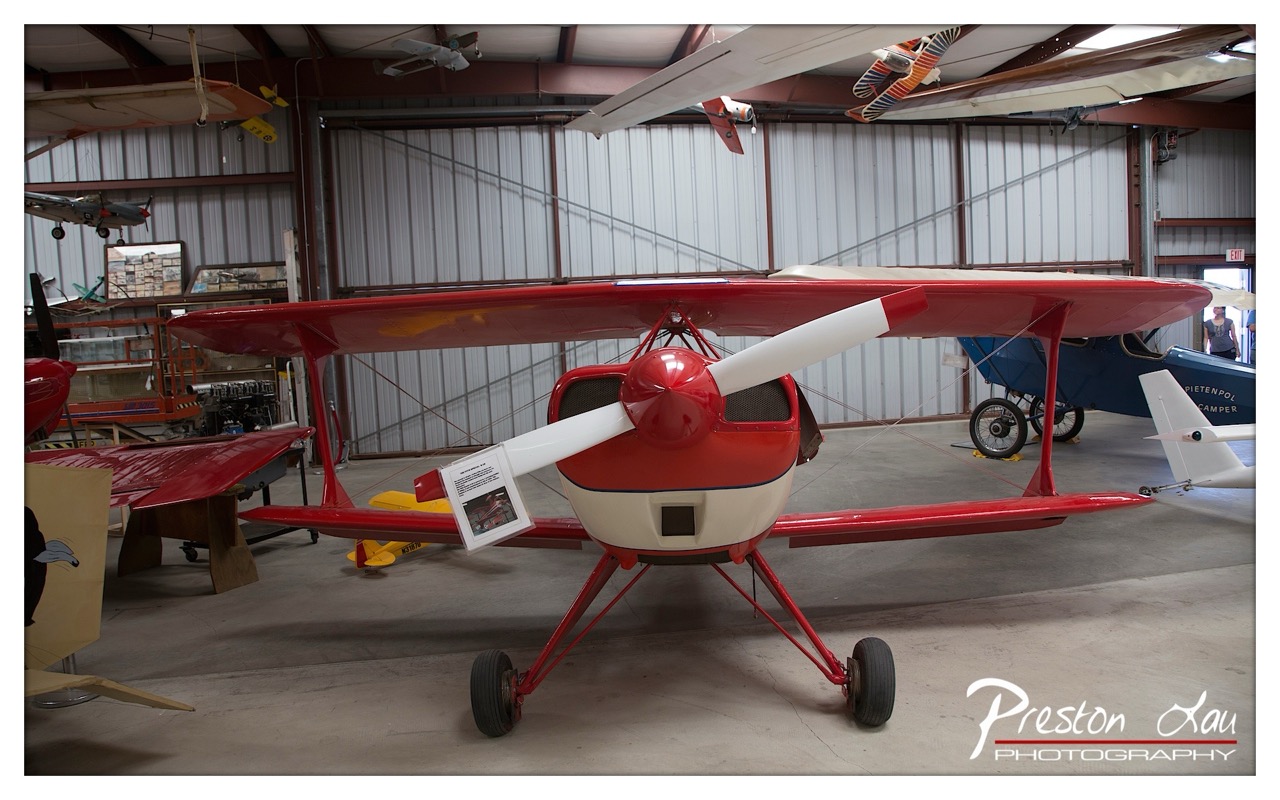

Hangar Star Biplane
Subject Rating: 7/10
This image captures a striking red and white biplane standing proudly in what appears to be an aviation hangar or museum. The plane, with its classic lines and prominent propeller, dominates the foreground, looking ready for takeoff if only the hangar doors were open. Surrounding it are hints of other aircraft – a large blue biplane in the background, a small yellow model plane near the wheel, and even hanging models from the ceiling, suggesting a space dedicated to the love of flight. The mood is one of quiet preservation, a snapshot of historical aircraft resting indoors, perhaps dreaming of open skies and barnstorming adventures. It feels like stepping into a personal collection or a smaller, less-polished aviation museum.
From a photographic standpoint, the composition places the main subject front and center, making its presence undeniable. The vibrant red of the biplane provides a strong focal point against the more muted industrial background of corrugated metal walls and concrete floor. However, the lighting appears somewhat flat, illuminating the scene evenly but lacking the dramatic shadows or highlights that could add depth and texture to the aircraft's form. The background, while relevant to the setting with other planes and hangar elements, feels a bit cluttered and distracts from the main subject. It's a straightforward, documentary-style shot, clearly intended to showcase the biplane itself, complete with the photographer's watermark boldly asserting ownership over this capture of aviation history.
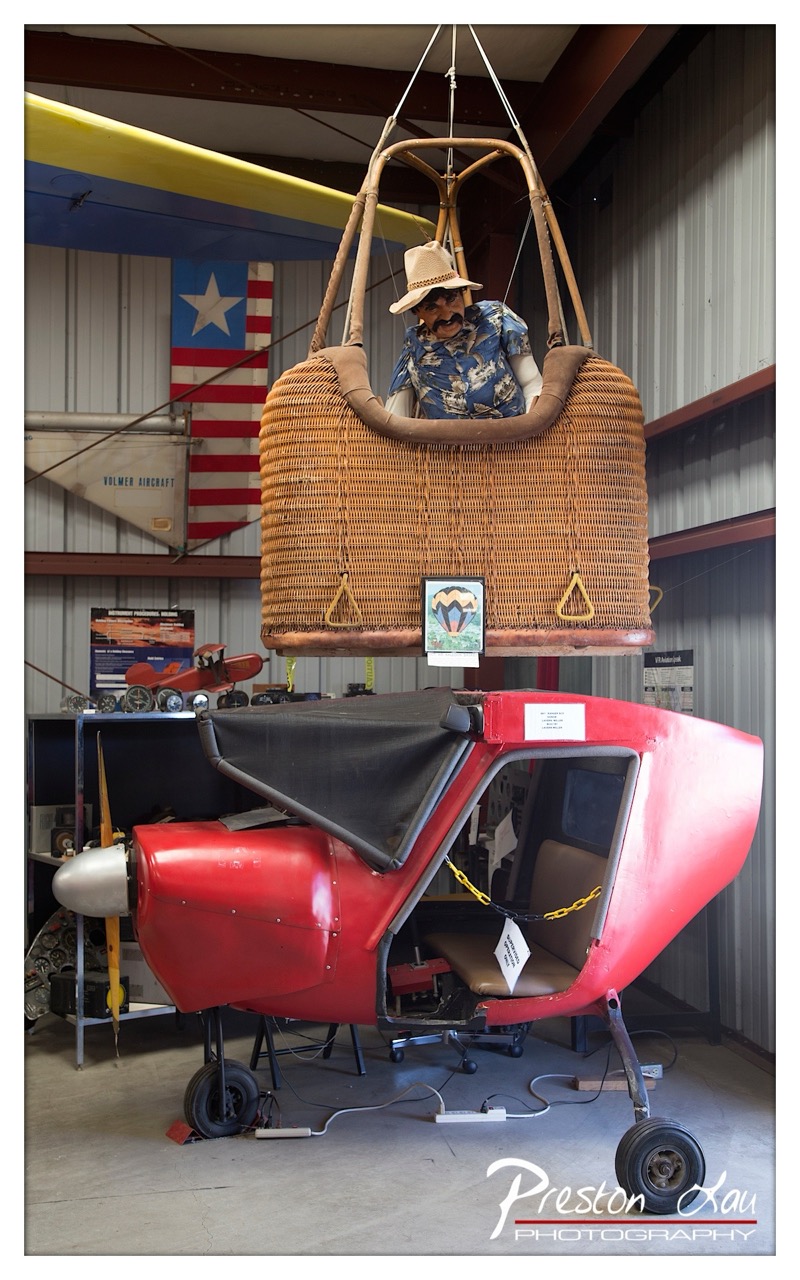

Aviation Odd Couple
Subject Rating: 7/10
Clearly, someone is aiming for altitude in more ways than one! We're looking at a rather unconventional scene in what appears to be an aircraft hangar or museum. Hanging prominently is a large hot air balloon basket, occupied by a rather dapper, straw-hat-wearing mannequin sporting a vibrant blue Hawaiian shirt and a magnificent mustache – a pilot clearly dressed for a tropical getaway, perhaps after landing. Below this airborne wicker wonder sits a compact, bright red, open-cockpit aircraft or ultralight, looking grounded and perhaps a little confused by its overhead companion. It's a delightful, slightly absurd juxtaposition of different flying machines, overseen by a silent, static aviator who subscribes to the "dress for the destination, not the journey" philosophy, suspended between two very different modes of flight.
From a photographic perspective, this shot captures the quirky nature of the display, though the vertical composition feels a tad constricted, perhaps dictated by the subjects' arrangement within the space. The lighting within the hangar creates some harsh shadows, particularly on the plane, and highlights the texture of the basket effectively, suggesting a mix of natural light and perhaps overhead fluorescents. The color palette is dominated by the warm browns of the basket, the bold red of the plane, and the industrial greys of the walls, punctuated by the colorful tail fin in the background hinting at other aviation history ("VOLMER AIRCRAFT"). While the background is a bit cluttered with shelves holding various objects, adding to the workshop feel, it also detracts slightly from the main subjects. The large watermark at the bottom, while understandable for attribution, is quite distracting, occupying a significant portion of the frame and pulling the eye away from the intriguing subjects. It's a snapshot of a wonderfully strange exhibit, full of character, even if the technical execution has a few bumps along the runway.
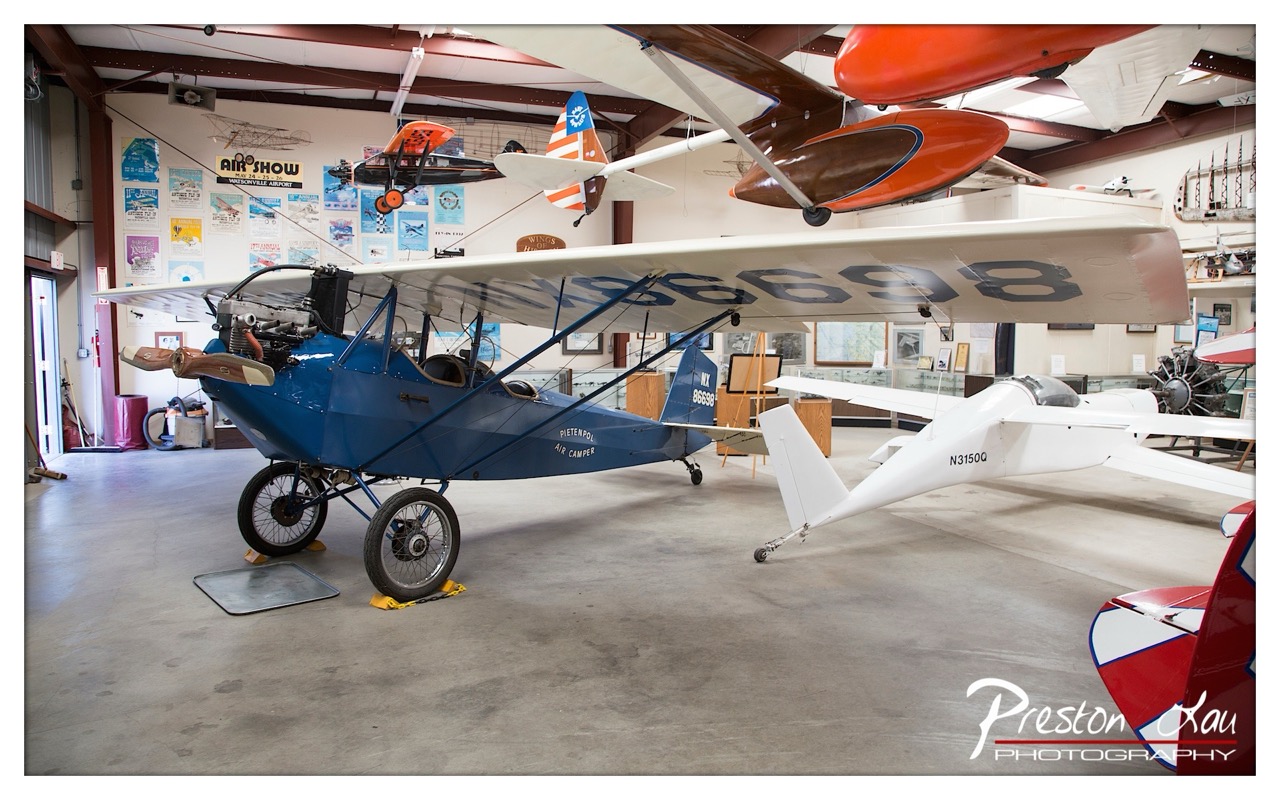

Museum Mayhem or Plane Pandemonium?
Rating: 7/10
Welcome to the ultimate airplane party inside what appears to be a cozy, if slightly chaotic, aviation museum or hangar. Our main attraction, a charming blue Pietenpol Air Camper (registration NX 86698) looking proud on its spoked wheels, is parked front and center. It's surrounded by fellow flying machines in a static display – a sleek white glider (N3150Q) posing behind it, and a whole squadron of aircraft suspended from the ceiling, including striking orange and brown models that add pops of vintage color. The overall mood is one of historical richness and busy preservation, like a gathering of old pilots sharing stories. The walls are adorned with classic airshow posters, painting a vibrant background that celebrates the golden age of aviation, complete with metal beams reminding us this is a sturdy, industrial space dedicated to these beautiful machines.
From a photographer's standpoint, this scene offers plenty of interesting subjects but is a bit of a compositional challenge. You've got the star blue plane, but the hanging aircraft constantly pull your eye upwards, and the white glider provides a strong secondary subject right behind the first. It's like trying to take a portrait while everyone else in the room is also demanding attention. The lighting is functional but uninspiring, typical of an indoor space with mixed sources, leading to some flat areas and potential glare, though thankfully not too severe here. While the subject matter is fascinating for aviation buffs, the density of objects makes the frame feel a little cluttered. And speaking of things demanding attention, the watermark at the bottom is hard to miss, though credit where credit is due – this photographer bravely ventured into the aircraft jumble to capture the scene. It’s a well-intentioned shot that tells a story, even if it gets a little lost in the hangar-sized visual buffet.
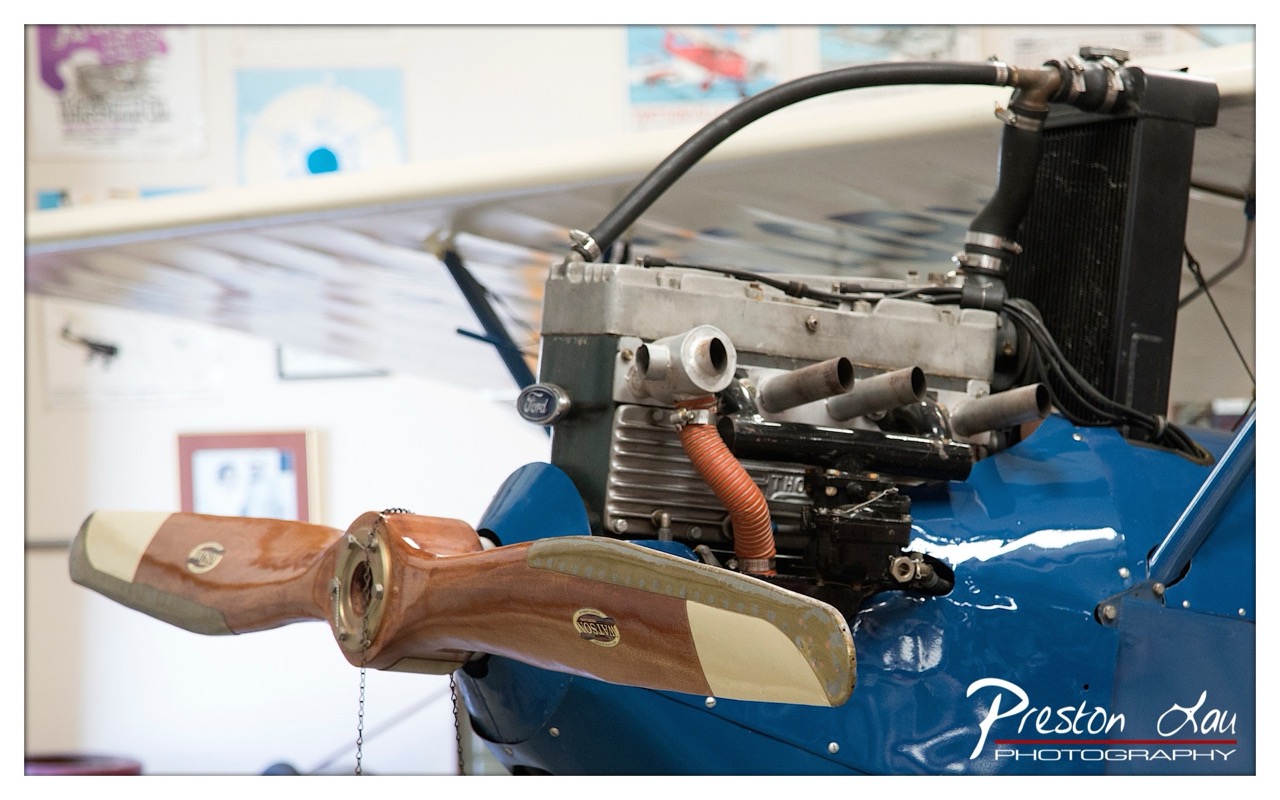

Vintage Ford-Powered Propeller Power
Subject Rating: 8/10
Behold the mechanical heart of a bygone era, a close-up shot focusing on the intricate workings of a vintage airplane engine and its elegant wooden propeller. Nothing dramatic is happening here, just a static display allowing us to appreciate the craftsmanship and engineering of yesteryear. The mood is one of quiet reverence for historical machinery, evoking nostalgia for early aviation days. The scene is dominated by the metallic grey engine block, complete with exposed exhaust stacks that look ready to roar, various hoses that twist like mechanical vines, and a radiator standing stoically. Prominently featured is a classic wooden propeller, its polished blades hinting at countless rotations through the air, and intriguingly, a small 'Ford' emblem suggesting this workhorse engine has roots in automotive royalty.
From a photographic standpoint, the composition is a tight frame, getting up close and personal with the engine details, though perhaps a step back might have allowed the full propeller tips to breathe a bit more. The soft, diffused lighting inside the exhibition space prevents harsh shadows but does create some rather enthusiastic reflections on the shiny blue paintwork below, making the aircraft look freshly polished. The color palette is a mix of industrial metallic tones, warm wood, and the vibrant blue of the fuselage, standing out against the blurred background of museum walls and hints of historical posters. The shallow depth of field effectively isolates the subject, drawing the viewer's eye to the mechanical marvels on display, while the photographer's watermark proudly stakes its claim in the bottom corner, ensuring credit for capturing this slice of aviation history.
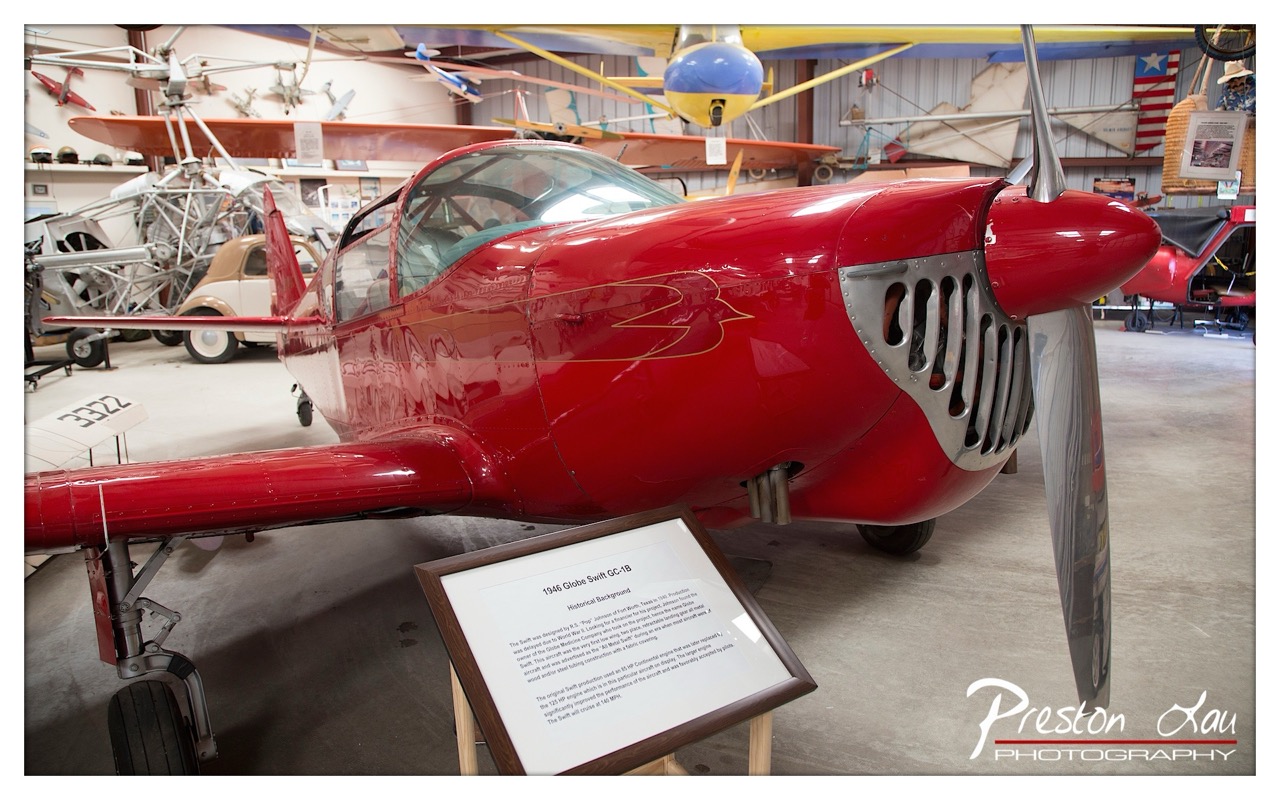

Ruby Red Revival in a Hangar
Subject Rating: 8/10
Well, hello there, Mr. Shiny Red Airplane! Posing like you're straight out of a vintage advertisement, the 1946 Globe Swift GC-1B certainly knows how to grab attention with that vibrant, glossy coat. What's happening here? Just a beautiful piece of aviation history sitting pretty in a museum or hangar, waiting for admirers to gaze upon its streamlined form and that magnificently retro propeller. The mood is one of preserved glory, a quiet dignity amidst the potential clutter of a storage space, though the sheer redness adds a touch of cheerful bravado. We've got the star subject – the plane's nose, prop, and wing section – dominating the frame, with a helpful information sign placed thoughtfully (or maybe awkwardly?) in the foreground to explain who this dazzling dame is. The style is documentary-meets-enthusiast, trying to capture the subject's beauty while battling the realities of the environment.
From a photographic perspective, this shot is a valiant effort, though not without its challenges. Compositionally, focusing tightly on the business end of the plane works, but the sign cutting into the bottom edge is a bit distracting, making the frame feel slightly unbalanced. Lighting seems to be a mix of overhead ambient and maybe some directional, resulting in those glorious (and sometimes tricky) reflections on the highly polished surface – note the reflections on the fuselage near the prop and tail. Color-wise, the red is punchy and saturated, providing a strong focal point against the muted concrete floor and the busy, somewhat chaotic background filled with the skeletons of other aircraft, storage shelves, and even a classic car in the distance. It tells the story of a working museum or collection space, which adds context but also visual noise. The exposure seems decent, capturing detail in both the bright red and the slightly darker interior elements. Overall, a good record of a stunning subject, even if the environmental portrait is a little crowded – perhaps a wider aperture could have helped isolate the Swift more effectively from the background chorus line. And yes, the watermark proudly proclaims the photographer, ensuring credit where credit is due for battling the reflective beast!
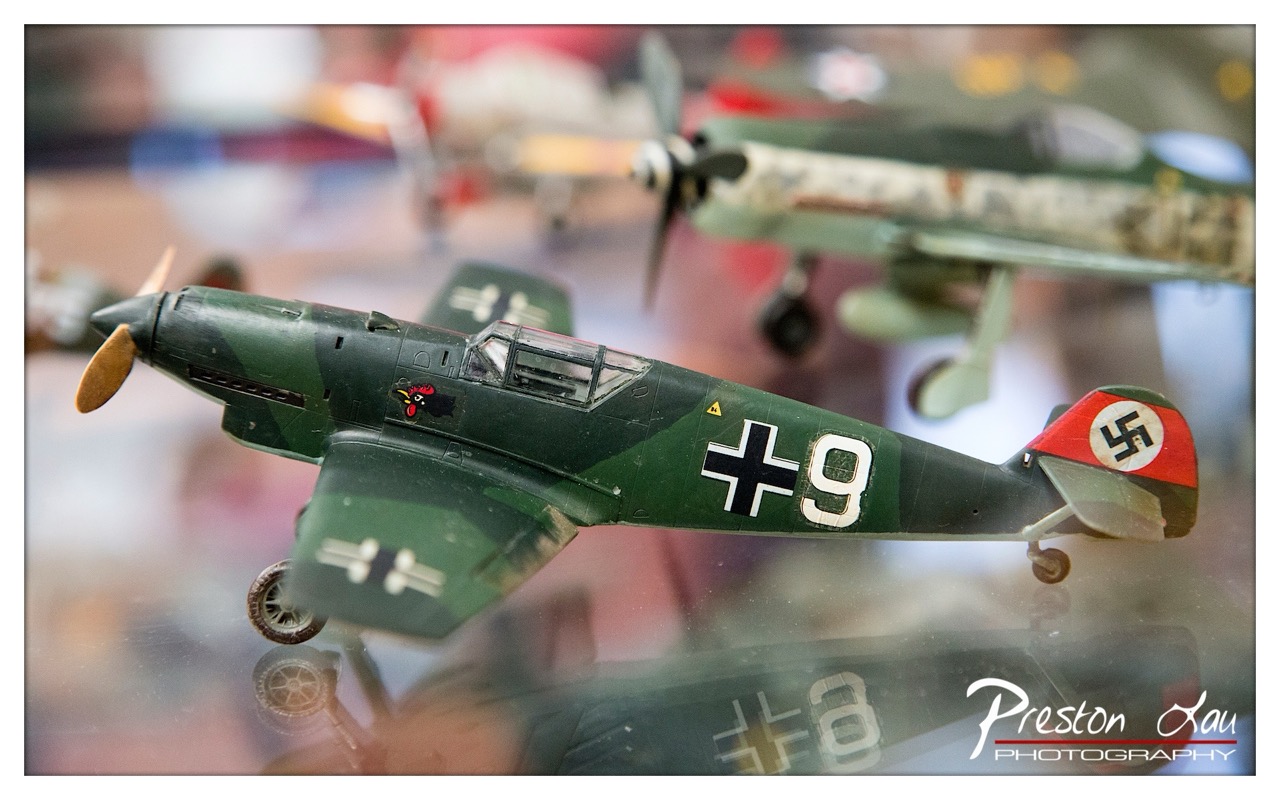

Desktop Ace
Rating: 8/10
Here we have a sharp, close-up portrait of a scale model Messerschmitt Bf 109, looking ready for a miniature sortie across a polished surface. The shallow depth of field does a fantastic job of isolating this historical subject, rendering the background into a painterly blur of color that suggests other items in a display or collection, but keeps our eye firmly on the main event. The mood is one of detailed examination and historical appreciation, capturing the intricate work of the modeler as much as the design of the aircraft itself. Pertinent objects include the weathered propeller, the detailed cockpit canopy, the landing gear wheel caught just in focus, and the prominent German cross and the number "9" on the fuselage, alongside a rather jaunty black rooster emblem just below the cockpit.
From a photography standpoint, the composition is dynamic, with the aircraft angled diagonally and the reflective surface providing a neat, albeit slightly soft, mirrored image below. The lighting highlights the contours and panel lines of the model effectively, emphasizing the camouflage pattern and markings. The focus is critically sharp on the mid-fuselage and wing root area, demonstrating precise technical execution. The bold black and white markings contrast well with the dark green and brown camouflage. While the historical subject matter is inherently serious, the context of it being a detailed model allows for an appreciation of craftsmanship and history captured through a lens. The watermark in the reflection adds a final touch, marking this excellent shot as belonging to Preston Lau Photography.
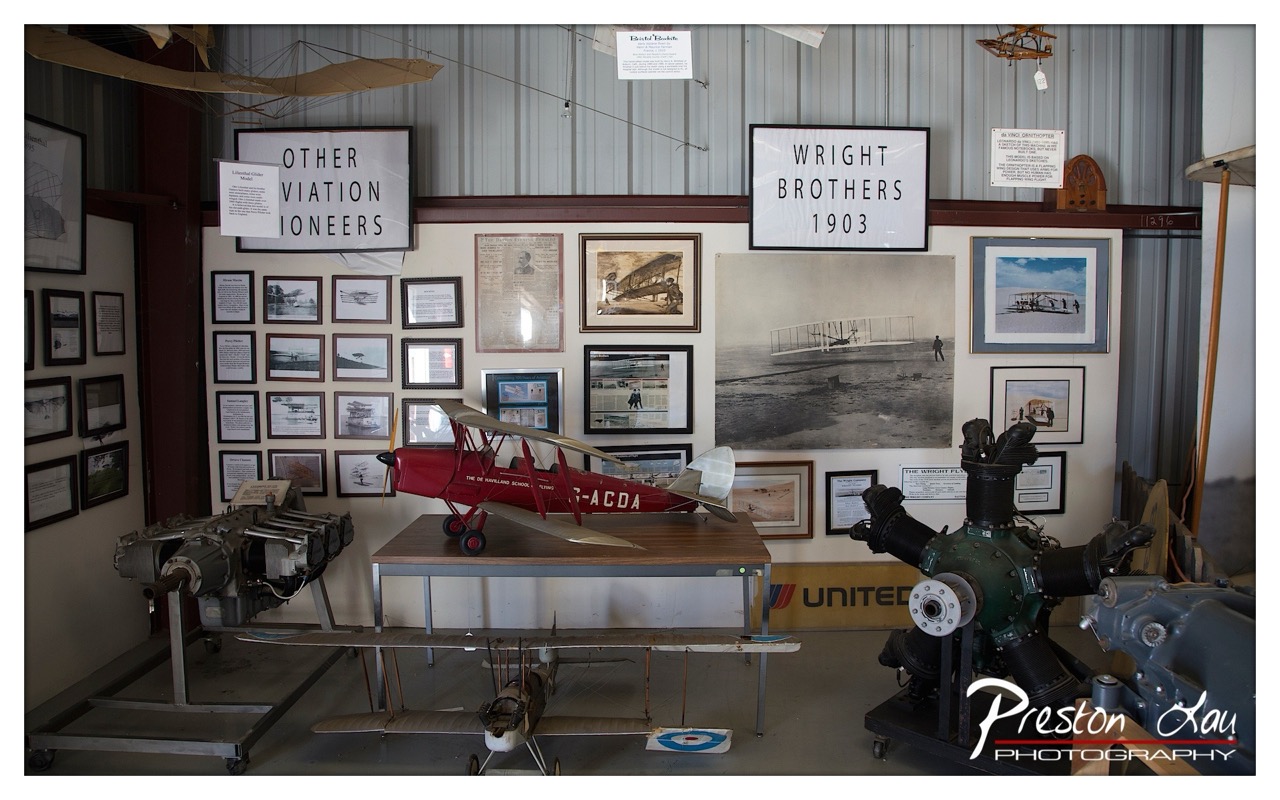

A Glimpse into Aviation's Humble Beginnings
Subject: 7/10
Step right up, folks, to this jam-packed visual feast of early flight! What we have here is a snapshot taken inside what appears to be a dedicated museum exhibit celebrating the brave souls who first dared to leave the ground, including the legendary Wright Brothers. The scene is a delightful (or perhaps slightly overwhelming) collection of historical artifacts: scale models of pioneering aircraft, including a rather fetching red biplane and some more rudimentary designs, stand ready for inspection alongside imposing vintage engines that powered these early contraptions. The walls are adorned with framed photographs and information boards, detailing everything from specific models like the "Bristol Racer" and a "Lilienthal Glider Model" to broader themes like "OTHER AVIATION PIONEERS" and the iconic "WRIGHT BROTHERS 1903". It's a veritable treasure trove of aviation history, conveying a mood of historical reverence mixed with the slightly chaotic charm of a passionately curated collection.
From a photographic standpoint, this interior shot is certainly *busy*. The composition feels layered, with multiple objects competing for attention from foreground to background, like a historical game of 'I Spy'. The camera is positioned relatively low, giving prominence to the engines and model planes upfront, while the wall displays recede slightly. The lighting appears to be a mix of ambient room light, perhaps fluorescent from the looks of the reflections on the metal wall siding, which is a bit flat and creates some unfortunate glare on the glass of the framed photos – classic museum lighting challenge! The colors are somewhat muted, letting the history speak for itself, though the bright red biplane model does provide a nice pop of contrast amidst the browns and greys of the engines and displays. While the subject matter is clearly presented despite the visual density, one might wish for a bit more breathing room or perhaps some selective focus to guide the viewer's eye. Despite the visual clutter, it successfully documents the impressive amount of aviation history packed into this space, even if it feels a little like they're trying to fit a Boeing 747's worth of history into a hangar for biplanes.
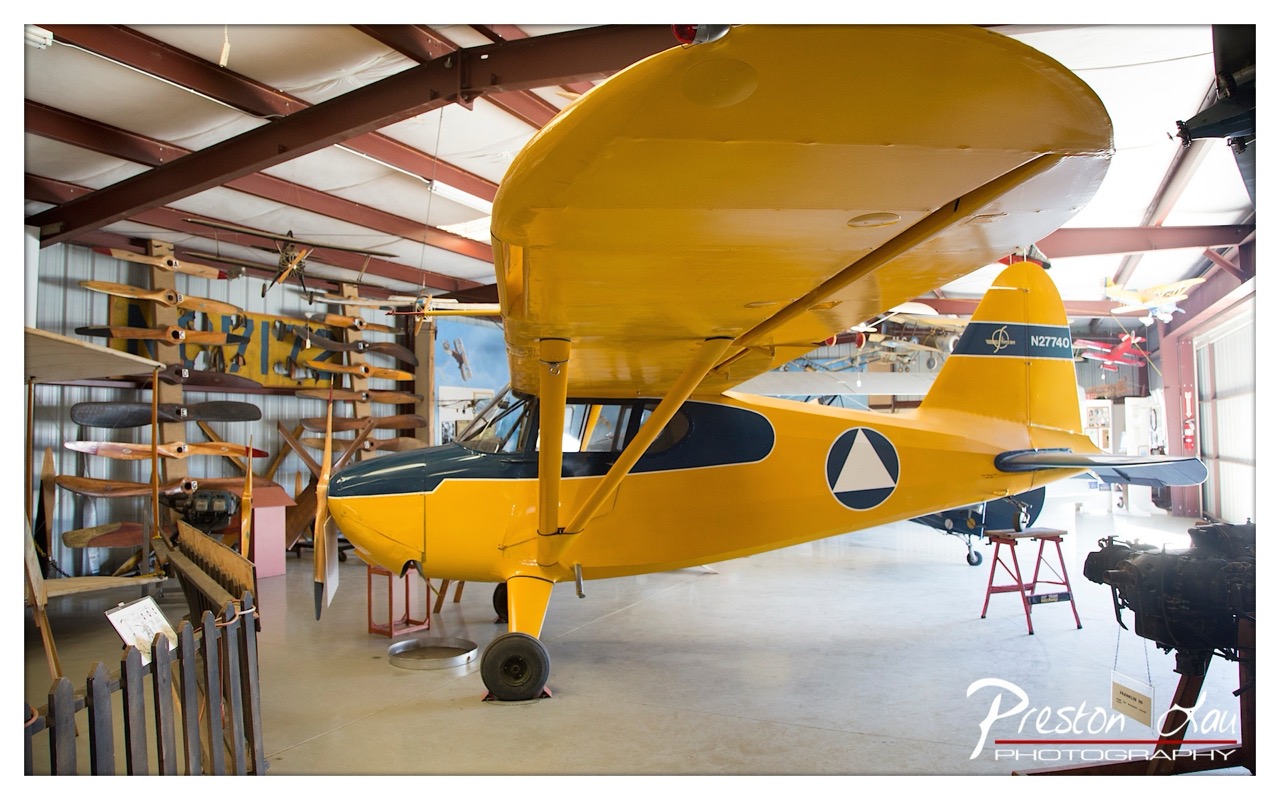

Yellow Bird in the Propeller Forest
Subject Rating: 9/10
Behold, a magnificent bright yellow beast, a high-wing aircraft (likely a classic like a Cub or similar design, sporting registration N27740) holding court in what appears to be a hangar or aviation museum. It's painted a cheerful, eye-blistering yellow with a smart dark green stripe along the cockpit, making it impossible to miss amidst the clutter. The aircraft is parked on a concrete floor, its sturdy landing gear visible, looking ready for action or perhaps just patiently waiting for visitors. The mood is one of historical preservation, a snapshot of aviation history tucked away in an industrial shell. What's happening is simply the static display of this lovely machine, a silent testament to bygone eras of flight, surrounded by its brethren and the tools of its trade.
From a photographic standpoint, this image is a delightful challenge of taming a busy environment. The composition places the vibrant yellow subject front and center, effectively using its size and color to dominate the frame. The low angle makes the plane feel substantial and impressive. Lighting appears to be a mix of overhead artificial sources and possibly some ambient light, creating reflections on the plane's surfaces but also casting some shadows. The background is a treasure trove (or a distracting mess, depending on your perspective) of aviation ephemera – a wall absolutely crammed with wooden propellers, an engine block, various stands, and even a tiny decorative fence. While busy, the background context does reinforce the theme of an aviation collection. The contrast between the clean lines of the aircraft and the industrial/storage vibe of the hangar structure (visible steel beams and ceiling) adds visual interest. The signature watermark of "Preston Grau Photography" is clearly visible at the bottom right, claiming ownership of this historical glimpse. Overall, it's a solid shot capturing a beautiful subject within its native, albeit cluttered, environment, making you wonder about the stories these old wings could tell.
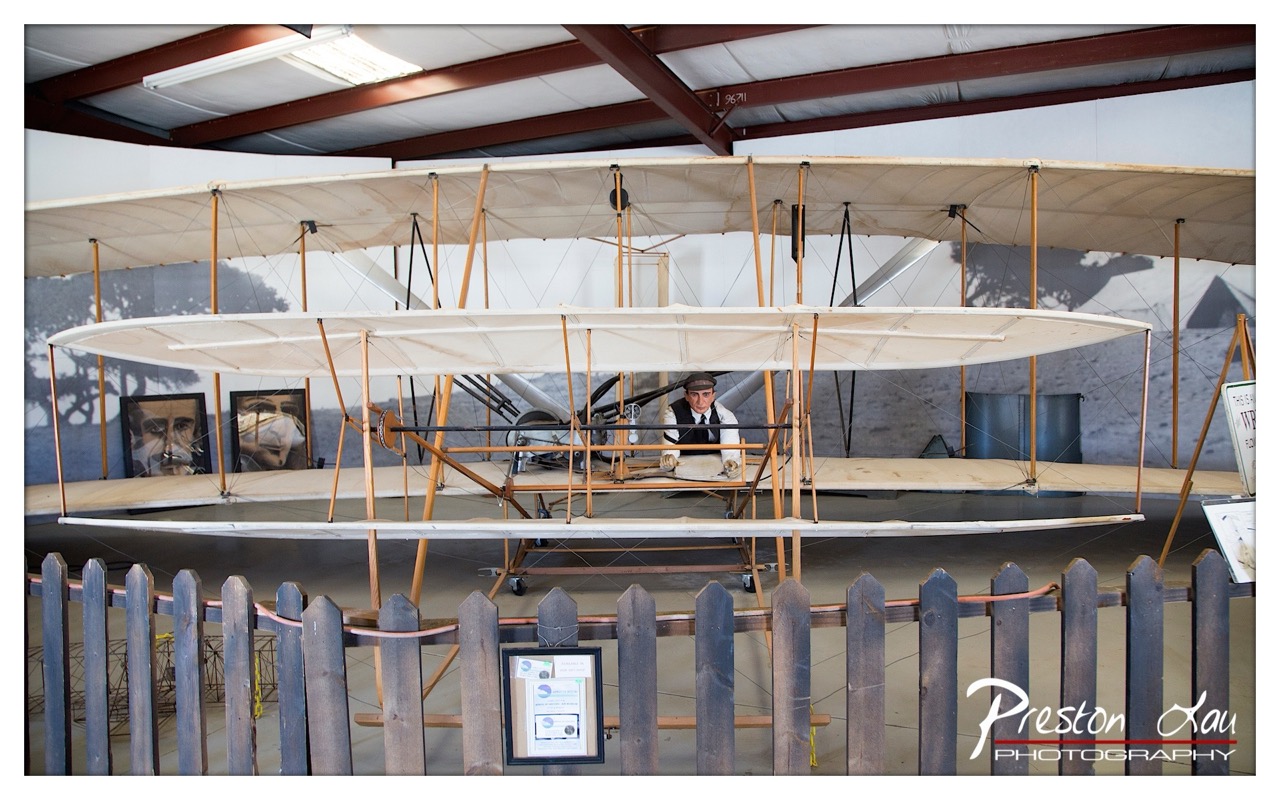

Early Bird Special
Rating: 7/10 (for historical subject appeal)
This image transports us back to the nascent days of aviation, showcasing a magnificent, if slightly dusty, replica or preserved early biplane, likely of the Wright Flyer era. Sitting stoically in the pilot's seat is a mannequin, dressed appropriately for the time, giving the scene a static, museum-like quality. The backdrop appears to be a hangar or exhibition space, complete with industrial lighting, metal beams, and a large painted or printed mural of tree silhouettes on the back wall, adding a touch of historical context, perhaps referencing the landscapes early aviators flew over (or crashed into). A rustic wooden fence in the foreground acts as a barrier, keeping eager onlookers (and rogue tumbleweeds) at a safe distance from this fragile relic. Framed portraits rest on the floor behind the aircraft, their subjects peering out as if observing the miracle of flight frozen in time.
From a photographic standpoint, the composition is dominated by the large, sprawling wings of the aircraft. While the biplane is impressive, the foreground fence creates a visual obstacle, chopping off the bottom of the frame and slightly diminishing the grandeur of the subject behind it – a classic museum photography challenge. The lighting is relatively even, courtesy of what appear to be overhead fluorescent or similar fixtures, which is good for general visibility but lacks the dramatic flair that could highlight the intricate details of the wooden frame and fabric wings. The color palette is muted, reflecting the materials of the era and the practical nature of the setting, emphasizing the functional form over flamboyant aesthetics. It's a straightforward, documentary style shot, capturing the subject clearly but perhaps missing an opportunity for a more dynamic or artistic portrayal of this incredible piece of history. The mannequin pilot, bless his cotton socks, does little to inject life into the scene, but hey, at least he won't complain about turbulence.
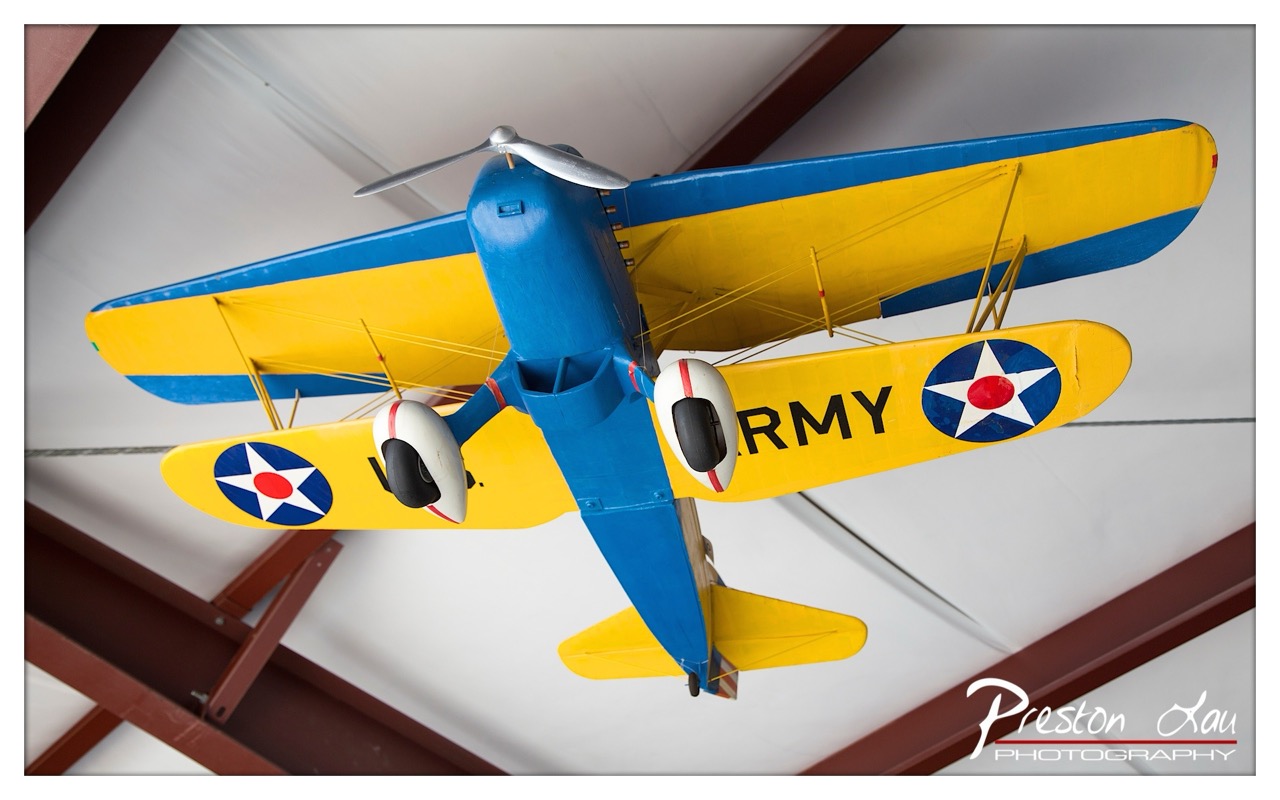

Classic Biplane Ceiling Ornament
Rating: 7/10
Well, look up! We've got ourselves a model biplane performing a daring aerial maneuver known as the "Perma-Suspension." This brightly painted beauty, sporting a striking yellow and blue livery reminiscent of early military trainers (complete with the "ARMY" text and U.S. Army Air Corps star insignia), is currently defying gravity with the help of some unseen wires. It's giving off a distinctly nostalgic and slightly melancholic vibe – a magnificent flying machine forever grounded, or perhaps just taking an extremely long break. The propeller is poised, the wheels (complete with spats!) are ready, but alas, the open sky remains a distant dream viewed only from a fixed, ceiling-level perspective. It’s a charming subject, frozen in time and space, serving less as an aircraft and more as extremely cool, oversized decor.
From a photographic perspective, this is a straightforward, well-executed shot focusing squarely on the subject. The overhead composition effectively isolates the biplane against the simple background, although the industrial beams intrude slightly, adding a touch of realism to the "hangar" setting, or perhaps just highlighting its captivity. Lighting is even and bright, doing justice to the vibrant yellow and bold blue colors which are the image's strongest visual element – they pop beautifully against the neutral white ceiling. The photographer chose a perspective that showcases the full wingspan and fuselage details, making it excellent for documentation purposes. However, the static, slightly tilted angle and the visible suspension wires (or strings) firmly place it in the realm of "model on display" rather than "aircraft in flight," which, while accurate to the scene, limits the sense of dynamic movement one might hope for in an aviation shot. Still, it's a clean image, well-lit, and captures the details of the model effectively, even if the subject's 'flight' plan is strictly horizontal.
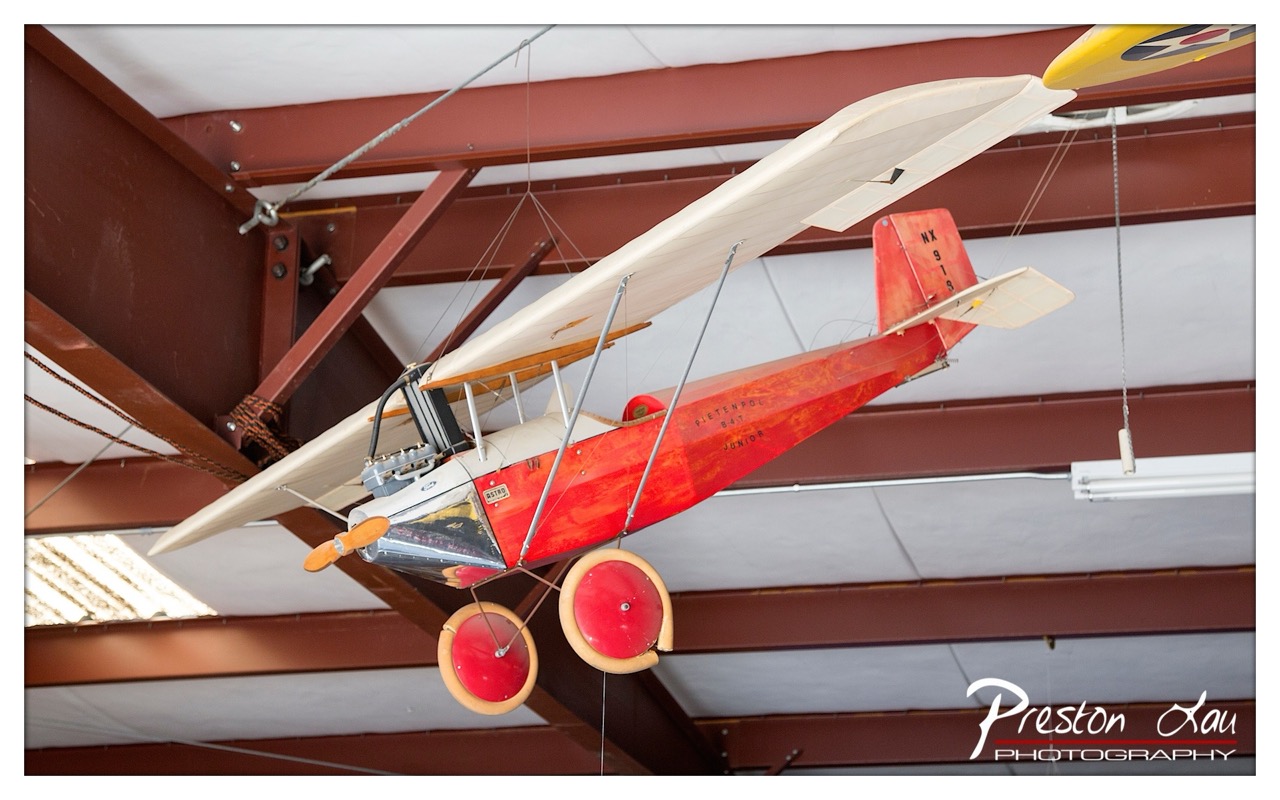

Suspended Aviation Dreams
Rating: 8/10
This photograph features a delightful red and white model airplane, identified on its fuselage as a "Pietenpol 84T Junior," hanging suspended from the ceiling. With its vintage charm, including a prominent propeller, large red wheels, and visible engine details, the plane looks ready for a theoretical takeoff, forever hovering mid-air. The scene feels like a peek into a private collection or perhaps a quiet corner of an aviation museum, evoking a sense of nostalgia for early flight and the meticulous craft of model building. The plane itself, with its distinct design and markings like "NX 919" on the tail, is a compelling subject, earning an 8 out of 10 for its character and detailed execution as a model.
From a photographer's standpoint, the composition utilizes the diagonal lines of the airplane and the supporting ceiling beams to add visual energy, though the perspective looking up can make the background structure feel a little imposing – almost like the plane is about to be swallowed by the hangar guts. The lighting, while functional in evenly illuminating the model, is somewhat flat; a touch more directional light could have brought out the textures of the wings or the sheen on the metal engine cowling, adding more depth and drama. The colors are pleasingly captured, the vibrant red of the fuselage standing out against the more muted tones of the background. It's a clean and informative shot, successfully capturing the essence of the model, though one might joke that getting the *actual* pilot's perspective might have been slightly more challenging than just looking up.
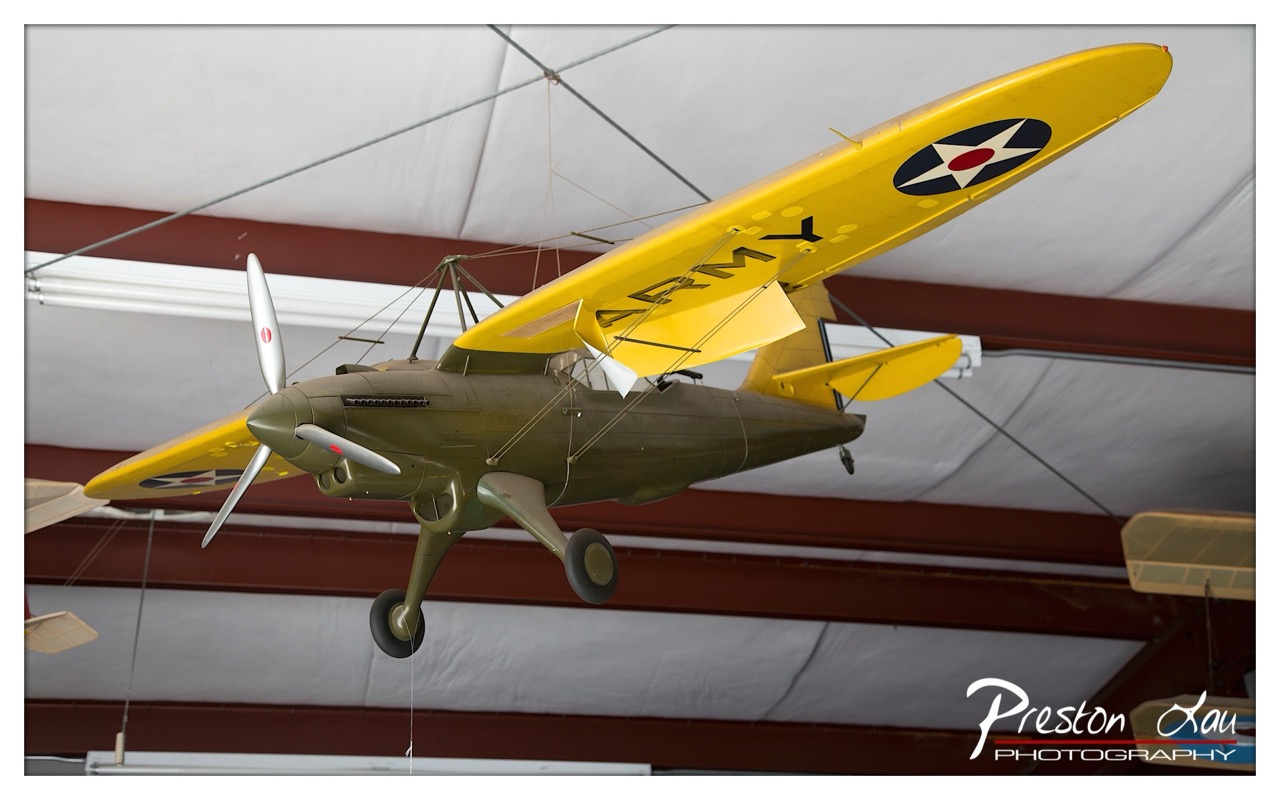

Hanging by a Thread of Nostalgia
Subject Rating: 9/10
This photograph captures a beautifully crafted model airplane, painted in classic olive drab and bright yellow, suspended from a ceiling. It appears to be a vintage US Army aircraft model, possibly from the inter-war period or early WWII, judging by the livery and design. The plane is meticulously detailed, featuring a propeller, landing gear, intricate rigging, and the distinctive US Army star insignia on the wing, with the word "ARMY" boldly printed along the yellow section. It's hanging statically, posed for the shot, seemingly part of a collection or display in what looks like a hangar or large building with a corrugated ceiling, exposed metal beams, and fluorescent lighting. The mood is one of quiet display, perhaps a bit nostalgic, highlighting the craftsmanship of the model. Other blurred hanging objects in the background suggest a larger collection is present.
From a photographic perspective, the composition angles the plane effectively to showcase its details, though the suspension wires are visible, grounding it (or rather, un-grounding it!) in reality. The lighting, likely ambient from the ceiling fixtures, is somewhat flat but ensures even illumination, which is useful for documenting details. The colors are vibrant, particularly the striking yellow of the wings, contrasting well with the green fuselage. The image quality is sharp, allowing the viewer to appreciate the model's intricate parts. While the background is slightly distracting with the other blurred objects and ceiling structure, it does provide context for the plane's location as a display piece. A bit of a challenge when shooting hanging subjects – you have to work with the angle they give you! It’s a straightforward, clear shot that successfully presents the subject, fitting for a collection showcase.
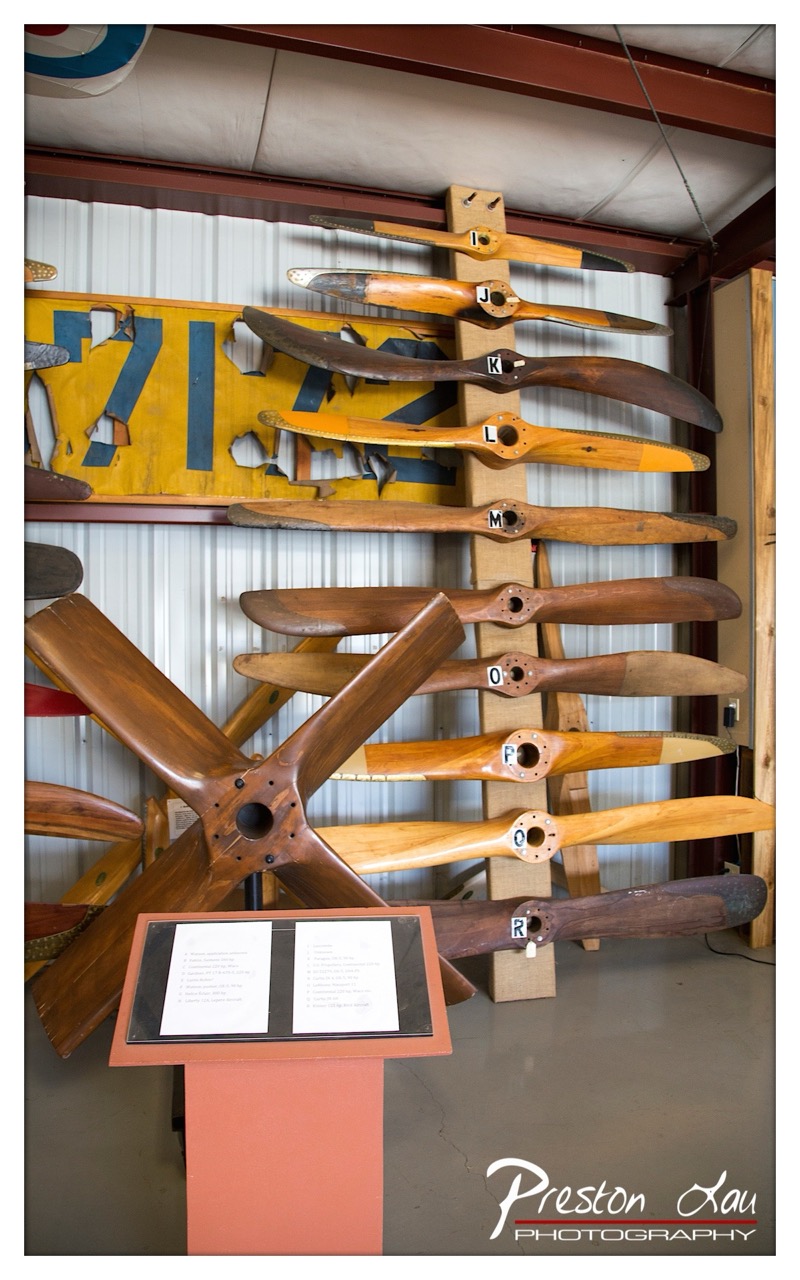

Propeller Paradise Pile-up
Rating: 7/10
This image captures a fascinating collection of antique wooden airplane propellers displayed in what appears to be a museum or aircraft hangar. In the foreground, a large, dark brown four-bladed propeller stands prominently on a stand, its complex hub visible, hinting at the power it once commanded. Behind it, a rack holds a series of single-bladed propellers of various sizes and wood types, each neatly labeled with a letter (I, J, K, L, M, O, P, R visible) for identification, like an educational lineup ready for inspection. To the left, a large, distressed yellow sign with blue numbers (looks like '71') and graphics adds a splash of faded color and texture to the scene, hanging against a backdrop of corrugated metal walls. Below the large foreground prop is a display stand with written information, adding context to these relics of aviation history. The overall mood is one of historical preservation and static display, showcasing the craftsmanship and evolution of aircraft propulsion.
From a photographic perspective, the composition is somewhat busy, attempting to capture several distinct elements at once. The large foreground propeller, while striking, competes with the rack behind it and feels slightly cut off at the bottom, especially the information stand. The vertical arrangement of the rack provides a strong linear element, contrasting with the angled blades of the foreground prop, but the sheer number can feel overwhelming. Lighting appears to be ambient and relatively flat, providing adequate illumination but lacking dramatic effect or depth. The color palette is dominated by warm wood tones, punctuated by the vibrant, though weathered, yellow sign and the reddish display stand, which adds some visual interest but also contributes to the sense of clutter. The documentary style effectively records the scene, but a different angle or depth of field might have helped isolate subjects or create a more dynamic image. And, of course, the photographer's watermark sits rather assertively in the lower right corner, perhaps trying to get as much attention as the props themselves.
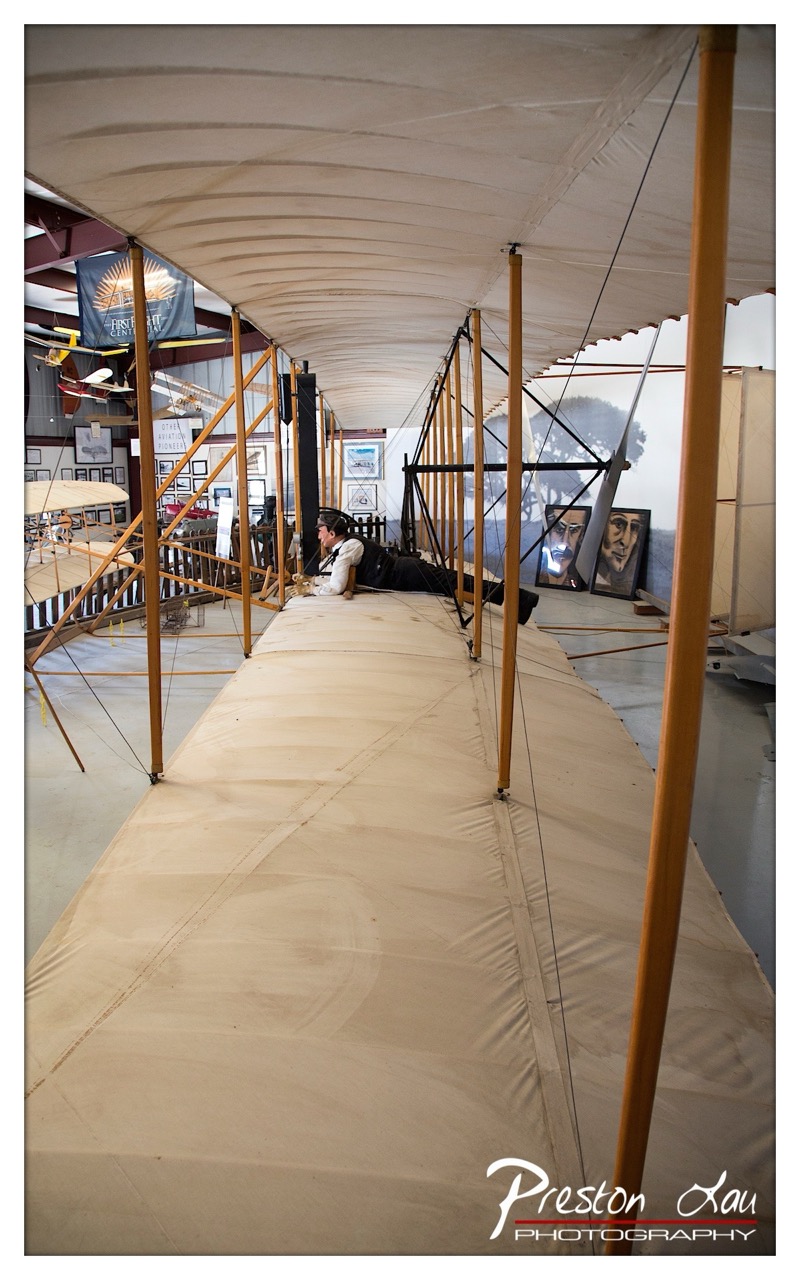

Prone to Greatness: A Wright Flyer Perspective
Behold, a magnificent replica of the Wright Flyer, rated a solid 8/10 for its historical accuracy and sheer audacity of design, complete with a mannequin pilot demonstrating the classic 'prone to greatness' flying position on the lower wing. Captured inside what appears to be a dedicated aviation museum or hangar, the mood is one of historical reverence, albeit slightly disrupted by the mannequin's unwavering gaze which suggests deep focus or perhaps just a severe case of rigor mortis. Wooden struts, taut wires, and acres of beige fabric make up the star of the show, supported by flags and framed artifacts on the walls behind, hinting at a rich history of flight. The background is a charming mix of educational displays, featuring photos and diagrams, creating a context-rich environment for this pioneering machine and ensuring you don't just see the plane, you understand the journey (even if the pilot is going nowhere fast).
The composition shines here, employing a low-angle perspective that emphasizes the scale and intricate structure of the aircraft, making it feel both monumental and surprisingly delicate. The vertical struts create a fantastic sense of depth and act as natural framing devices, drawing the eye down the length of the wing towards the distant tail section and that perpetually committed mannequin. Lighting is mostly ambient, providing a soft, even wash across the fabric wings, though the mannequin seems to have caught a bit of unfortunate glare on its face – perhaps proof that even early aviators struggled with harsh lighting conditions. The color palette is appropriately muted, focusing on the natural tones of wood and fabric, lending an authentic, vintage feel to the image. It's a classic documentary style shot, well-executed to highlight the subject's form and context, proving that sometimes, the best way to photograph history is to get down on its level (literally).
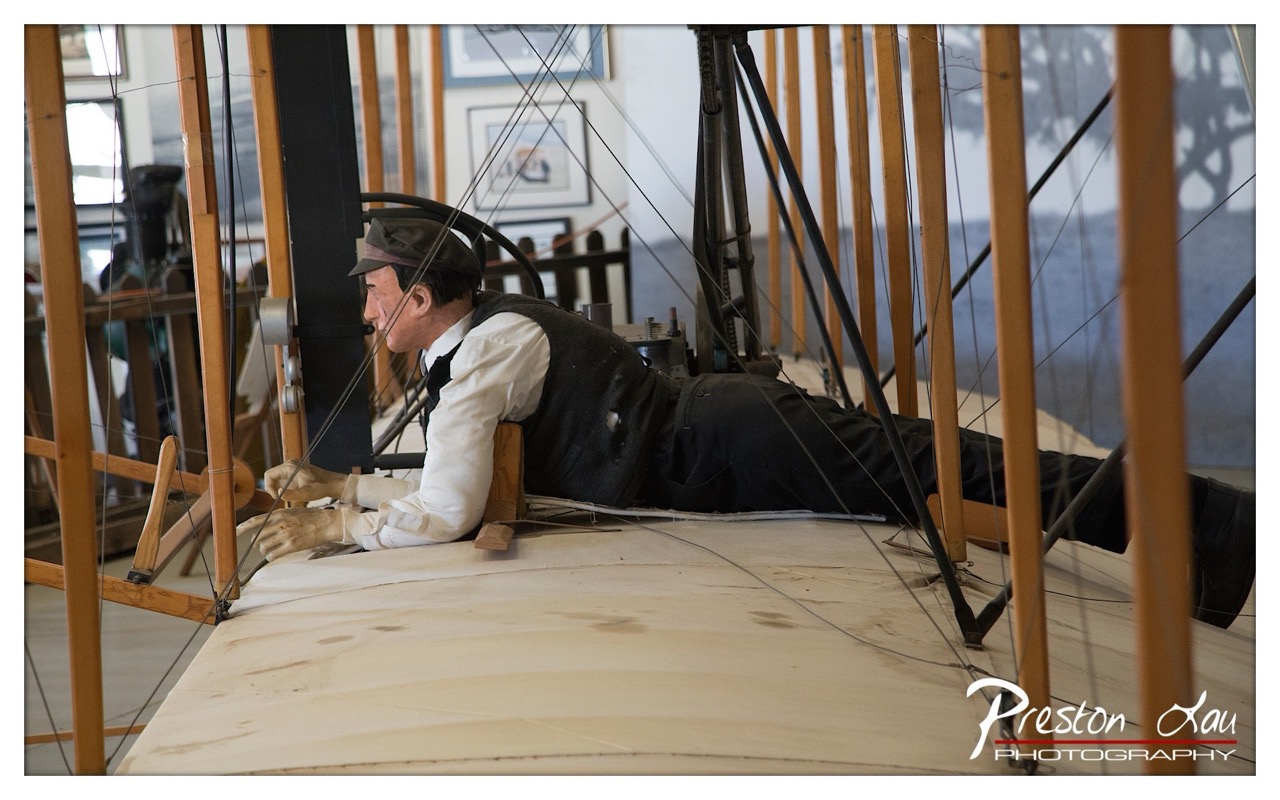

Early Bird Gets the Worm, or Maybe Just a Stiff Neck
Rating: 7/10
Welcome aboard the original lay-flat seat! This image captures a rather stiff-looking subject – a mannequin pilot rated a solid 7/10 for its stoic dedication to historical accuracy, if not dynamic movement – demonstrating the less-than-luxurious prone position required to operate one of aviation's earliest marvels. Our intrepid, unblinking aviator is sprawled out on the fabric wing of what appears to be a replica or original early aircraft, perhaps channeling their inner Wright Brother. The scene is steeped in a historical, museum-like tone, showcasing the rudimentary yet ingenious engineering of the time. You can almost hear the gentle hum of a non-existent engine and the creak of wood, set against a softly blurred background of framed exhibits and a distant, shadowy figure – presumably another relic of the past, or maybe just someone who realized standing was invented.
From a photographic perspective, the composition is interesting, employing a low angle that emphasizes the aircraft's structure, drawing the eye along the mannequin's body and into the intricate web of wooden struts and wires. It's a study in lines and angles, though the slightly cluttered background is a mild distraction from the main subject. The lighting is soft and diffused, typical of indoor museum settings, which keeps shadows gentle but doesn't add much dramatic flair – perhaps a touch more contrast could have highlighted the textures. The muted color palette perfectly matches the vintage subject matter, adding to the historical feel. While the pose is inherently static, the composition effectively conveys the unique operational setup of these pioneering flying machines. And credit where credit is due, "Preston Lau PHOTOGRAPHY" captured the scene, ensuring this historical vignette is preserved, complete with proof of who was brave enough to photograph the pilot who clearly preferred napping on the job.
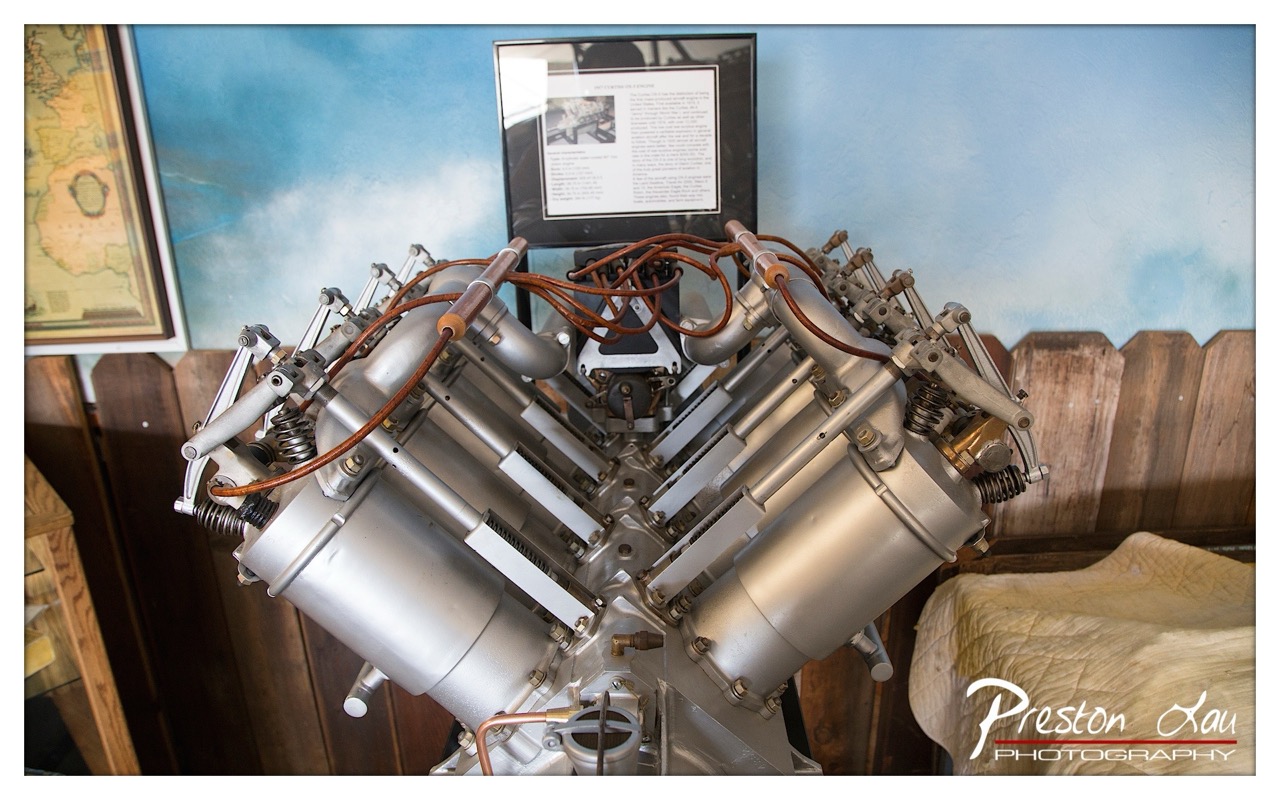

Greasy Old Timer
Subject Rating: 7/10
Behold, the magnificent, oily heart of some bygone machine! This imposing V-shaped engine, looking rather dapper for its age in polished silver, is the clear star of the show, proudly displayed like a mechanical trophy. Flanked by its intricate network of pipes, wires (looking suspiciously like they might carry grease or spark plugs?), and valve train components, it sits ready for inspection, or perhaps just longing for a drop of oil and a good old-fashioned crank. The mood is one of historical reverence, albeit for something that probably made a heck of a racket in its prime. The background scene hints at a museum or collection, with a framed map suggesting exploration or aviation history, a painted sky mural providing a rather whimsical backdrop, and a slightly rough wooden fence suggesting perhaps a more rustic or outdoor setting for this metallic beast. There's also a fuzzy-looking object covered in fabric on the right, adding a touch of mystery – is it another exhibit, or just some forgotten prop?
From a photography standpoint, the composition is straightforward and effective, centering the engine and using a slightly low angle to emphasize its bulk and complexity. The lighting seems relatively soft and diffused, which is a good call for metallic subjects to avoid harsh reflections, although it does leave some areas a bit flat. The limited color palette of silver, browns, blues, and wood tones keeps the focus squarely on the engine, which is good, though the busy background elements, particularly the map and fence, compete for attention a little more than ideal for a clean product shot. The style is typical for displaying artifacts – well-lit and frontal – aiming for clarity over artistic flair, though the choice of background adds a touch of unexpected visual texture. And yes, the signature "Preston Lau PHOTOGRAPHY" is tastefully watermarked on the bottom right, just in case you forget who captured this glorious hunk of metal. It's a solid capture of a fascinating, if slightly dusty, piece of mechanical history.
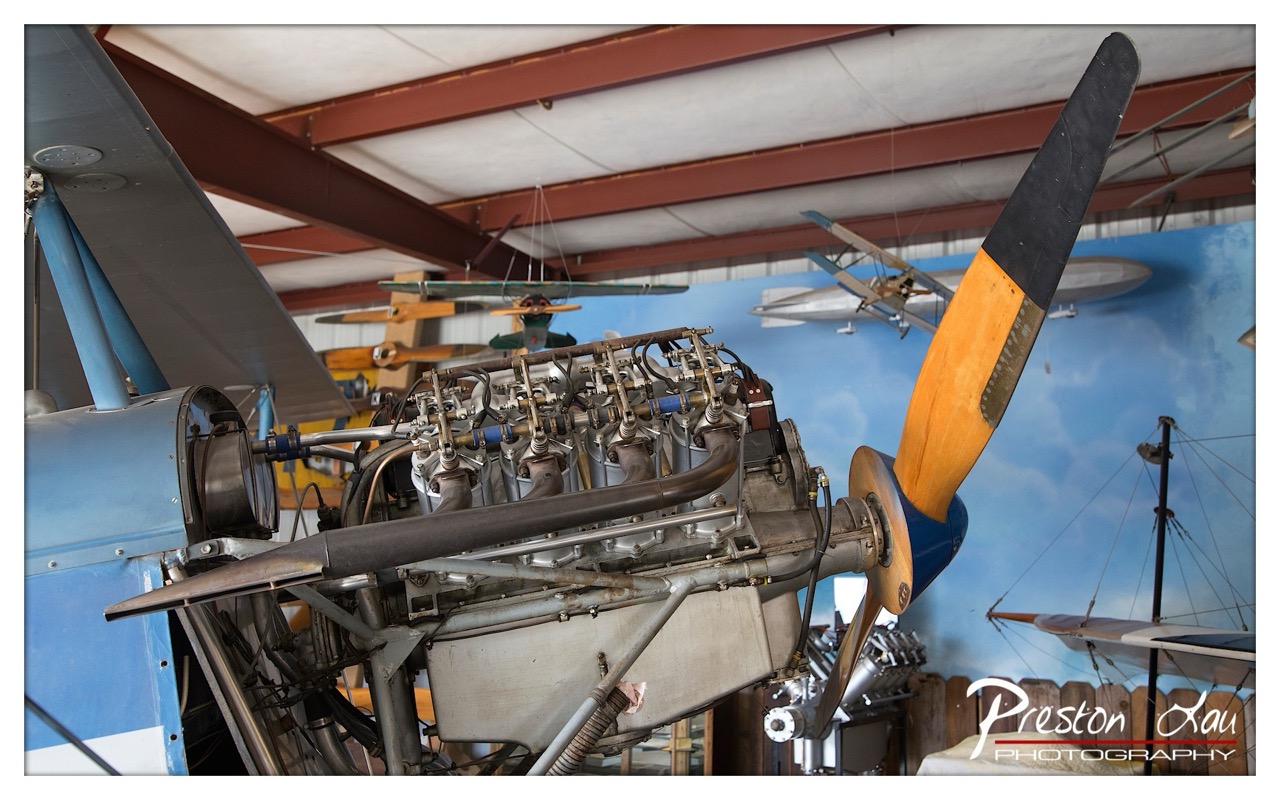

Vintage Powerhouse Detail
Subject Rating: 8/10
This shot dives headfirst into the mechanical heart of a classic flying machine, presenting a detailed view of a substantial inline aircraft engine and its wooden propeller. What's happening here is a close examination of vintage engineering, likely part of an aircraft display in a museum or private collection. The mood is one of historical appreciation and perhaps a touch of awe at the complexity of early flight technology. Compositionally, it's a bold, dynamic close-up, with the engine dominating the center-right and the aircraft's wing slicing through the left side. While the detail is fantastic, the framing feels a little tight, almost like the engine is trying to escape the frame, giving it an energetic feel despite being static. The leading lines from the engine exhaust and wiring draw the eye into the intricacies of the machinery.
From a technical standpoint, the lighting is functional but not particularly dramatic, effectively illuminating the engine's details without harsh shadows, though some highlights on metal surfaces hint at a strong light source nearby. The color palette is rich in metallic grays, deep blues, and the warm tones of the wooden propeller, providing a realistic portrayal of the subject matter. The background, featuring other suspended aircraft against a painted sky mural, adds context but also contributes to a slightly busy feel – it's clear this is a working or display environment rather than a sterile studio. The style is documentary, focusing on capturing the intricate detail of the machinery, making it valuable for reference, even if the background elements are a bit distracting. It's a great look at what powered early aviation, a reminder that sometimes the beauty is in the nuts, bolts, and cylinders.
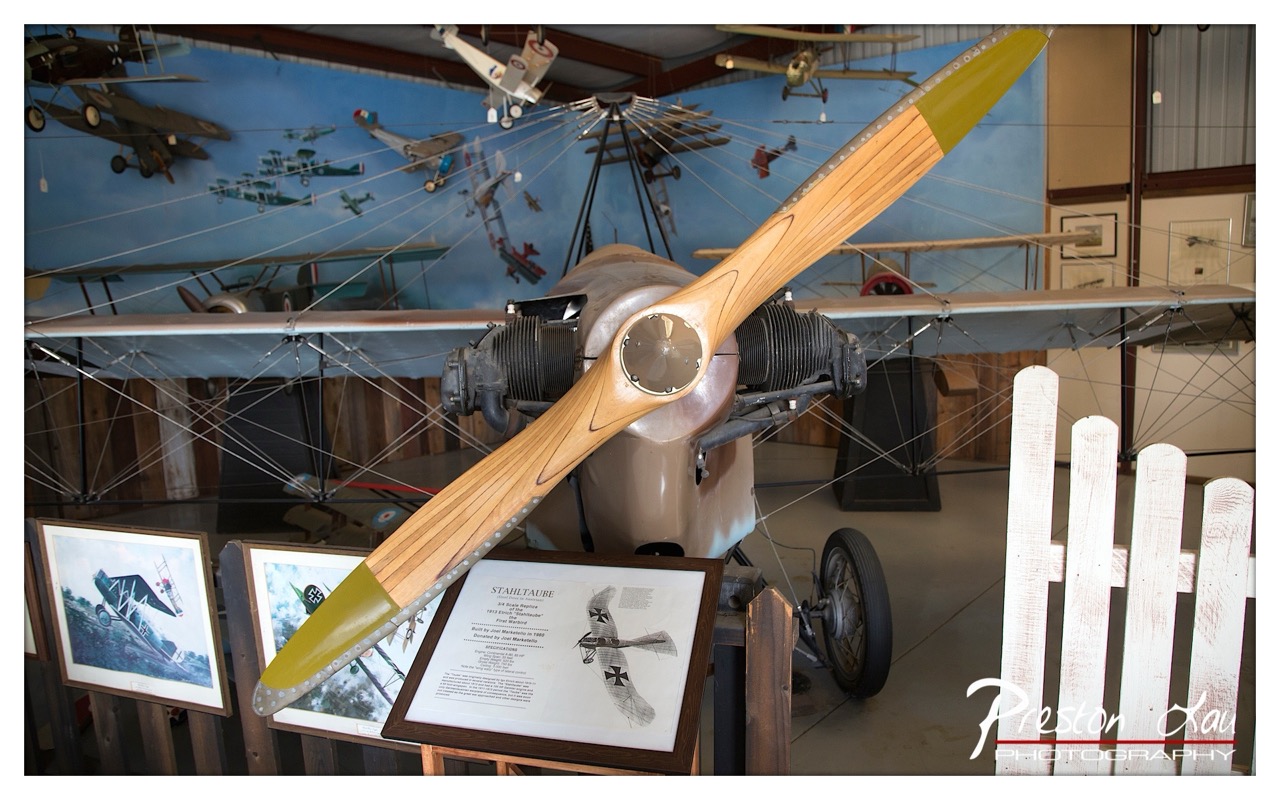

Propeller Powerhouse in the Museum Sky
Subject Rating: 7/10
This image captures a densely packed museum exhibit dedicated to vintage aviation, with a prominent focus on a striking wooden propeller of a ground-level aircraft. The subject, identified by a nearby sign as a 3/4 scale replica 1913 Etrich "Stahltaube," stands front and center, its large propeller acting as the dominant visual element, almost overpowering the rest of the airframe. The backdrop is a captivatingly busy scene featuring a painted blue mural depicting various vintage planes in flight, augmented by numerous model aircraft hanging from the ceiling, creating a layered sense of a bustling historical sky. Two framed pictures and a sign providing details about the exhibit are visible in the foreground, adding context, while a section of a white picket fence on the right edge introduces an unexpected domestic touch to the historical setting. The overall mood is one of historical immersion, albeit slightly cluttered, showcasing a passion for early flight.
From a photographic perspective, the composition is heavily influenced by the sheer scale and placement of the propeller, which creates a strong diagonal line cutting across the frame. While effective in highlighting this key component, it also serves to visually divide the image. The background, though rich in detail and context, suffers from being incredibly busy, leading to a somewhat chaotic feel that competes for attention with the main subject. Lighting appears to be typical museum ambient light – functional, but lacking dramatic flair, resulting in relatively flat illumination across the scene. The colors are predominantly muted browns and greys, typical of the aircraft and wooden structures, with the blue of the mural providing a splash of contrast and the yellow tips of the propeller adding a small point of interest. The inclusion of the fence on the right feels a bit awkward, adding a slightly random element to the framing. Photographing such a complex, layered exhibit is challenging, and while this image documents the scene, a different perspective or perhaps a wider aperture to isolate the subject from the busy background might have enhanced its impact. It's a solid documentary shot of the exhibit, successfully conveying the wealth of items on display, even if the composition feels a touch overwhelmed.
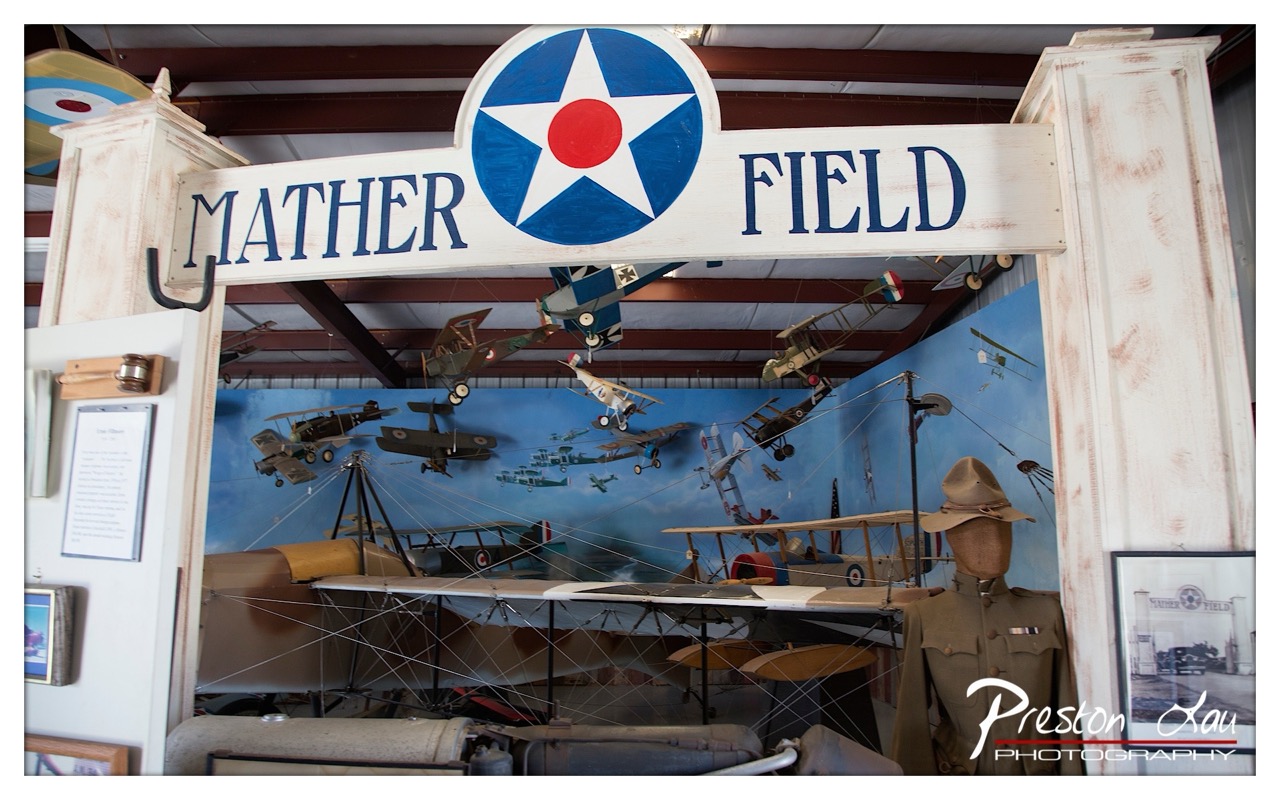

Mather Field Fly-In Frenzy
Rating: 8/10
Stepping through this threshold feels less like entering a museum exhibit and more like navigating a particularly enthusiastic diorama of World War I aviation. The "Mather Field" sign, complete with a perfectly centered US roundel, acts as a grand, albeit slightly distressed, portal into this aerial world. Hanging in what appears to be organized chaos are countless model biplanes and early aircraft, suspended mid-dogfight against a painted backdrop of a rather serene blue sky. Down below, a stoic mannequin in a period uniform seems ready for inspection, perhaps pondering the strategic value of surrounding himself with so many fragile flying machines. Pertinent objects abound, from a judicial-looking gavel on a nearby wall display to the disassembled parts of a larger aircraft model in the foreground, adding layers to this densely packed historical scene. The overall mood is one of earnest historical preservation, a testament to a bygone era of flight.
From a photographic perspective, the composition here is a brave attempt to capture the sheer volume of the exhibit, using the entrance structure to frame the scene. However, the density of the subject matter, with models overlapping and wires crisscrossing, can feel a bit overwhelming – like trying to photograph a tangled kite string collection. The lighting is functional, illuminating the main elements, but lacks dramatic flair, leaving some of the deeper background models in shadow. The color palette leans towards muted historical tones, fitting the WWI theme, but doesn't pop. While the documentary style effectively captures the state of the exhibit, a photographer looking to highlight specific details might benefit from a tighter crop or different angle. Still, it's a well-executed record of the space, complete with the photographer's watermark, a clear sign that someone was documenting this impressive array of model aircraft and historical artifacts.
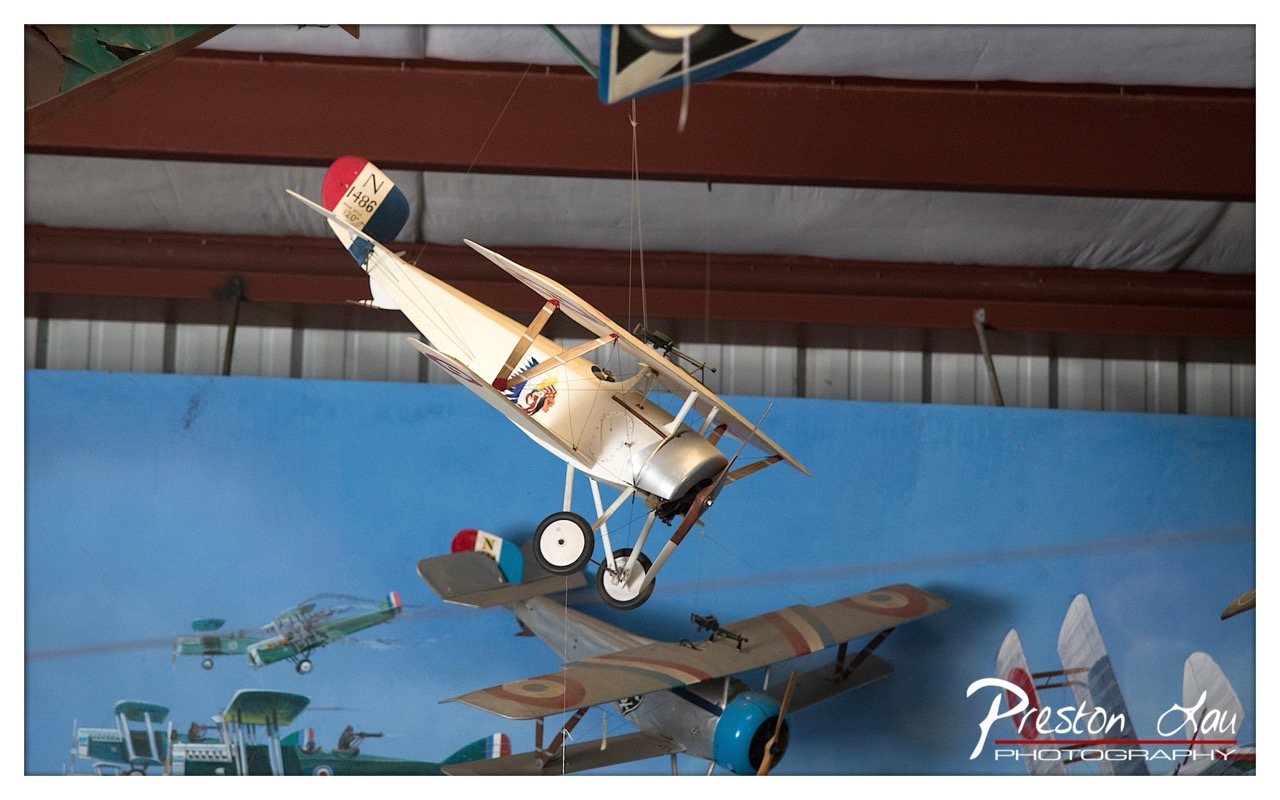

Suspended Squadron
Rating: 8/10
Behold, a gravity-defying ballet of miniature aviation history! This photograph captures a fantastic collection of model biplanes, dramatically suspended against a vibrant blue backdrop painted with even more aircraft, creating a layered sense of aerial action. Dominating the frame is a crisp white biplane, sporting a fierce shark-mouth decal and intricate rigging, looking ready to soar (or at least gently dangle) into the painted sky. Below it, other vintage-style models join the formation, their wings adorned with period markings, suggesting a museum exhibit or a truly dedicated hobbyist's ultimate display. The blue wall provides a bright, contrasting stage, punctuated by the structural beams of the ceiling above, anchoring the whimsical scene in a very real space.
From a photographic perspective, the composition places the primary model front and center, allowing its details to shine. The lighting is functional, clearly illuminating the models without harsh shadows, though perhaps a more dramatic side light could have enhanced the sense of three-dimensionality and movement. The focus is sharp on the main subjects, capturing the delicate wires suspending them and the intricate craftsmanship. While the blue background is a nice concept, the slight blur and simplified rendering of the painted planes contrast sharply with the detailed models, creating a visual divide. The watermark, tastefully placed, confirms this is someone's proud photographic capture of their (or someone else's) passion project. Overall, it's a clear, well-executed shot that effectively showcases the subject, even if it doesn't push any boundaries in photographic technique.
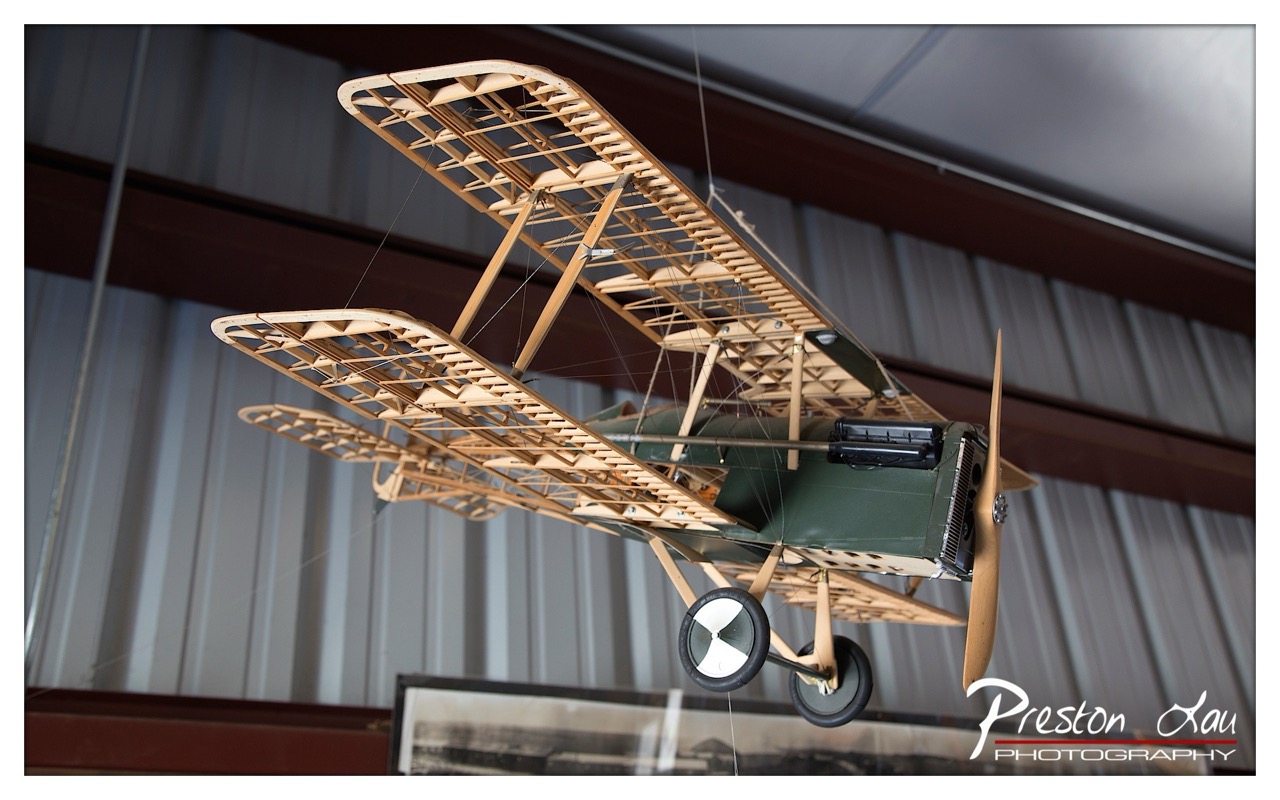

Title: Biplane's Eternal Hangar Float
Rating: 8/10
Well, this isn't your average bird waiting for takeoff, is it? It's a beautifully detailed scale model biplane, suspended mid-air as if permanently grounded in the heavens of a rather industrial-looking building. The subject itself is fantastic – the intricate wooden structure of the wings and fuselage is a testament to serious craftsmanship, earning it a solid 8 out of 10. You can practically feel the balsa wood! The plane is captured at an interesting angle, tilting slightly upwards and towards the camera, showing off its multiple wings, landing gear, and chunky propeller. It feels like a snapshot of a proud display piece, perhaps a labor of love now occupying prime real estate in a workshop or hangar-like space. The mood is one of quiet permanence, a static display piece enjoying its eternal float.
From a photography perspective, the composition wisely focuses heavily on the plane, allowing the details of the model to shine. The angle adds dynamism to a static subject. The lighting appears to be natural or diffuse ambient light, which works well to avoid harsh shadows and highlight the delicate framework of the wings. The shallow depth of field is effective in isolating the plane from the background, making it the undisputed star, though the blurry foreground frame is a bit distracting. The background itself, composed of corrugated metal siding and dark overhead beams, provides a stark, utilitarian contrast to the classic elegance of the biplane model. The muted color palette of the plane (greens, browns, wood tones) contrasts nicely with the cool grey background. One could argue about the placement of the watermark, but hey, gotta protect that craft! It’s a competent shot that clearly showcases the impressive model, even if it feels a tad static.
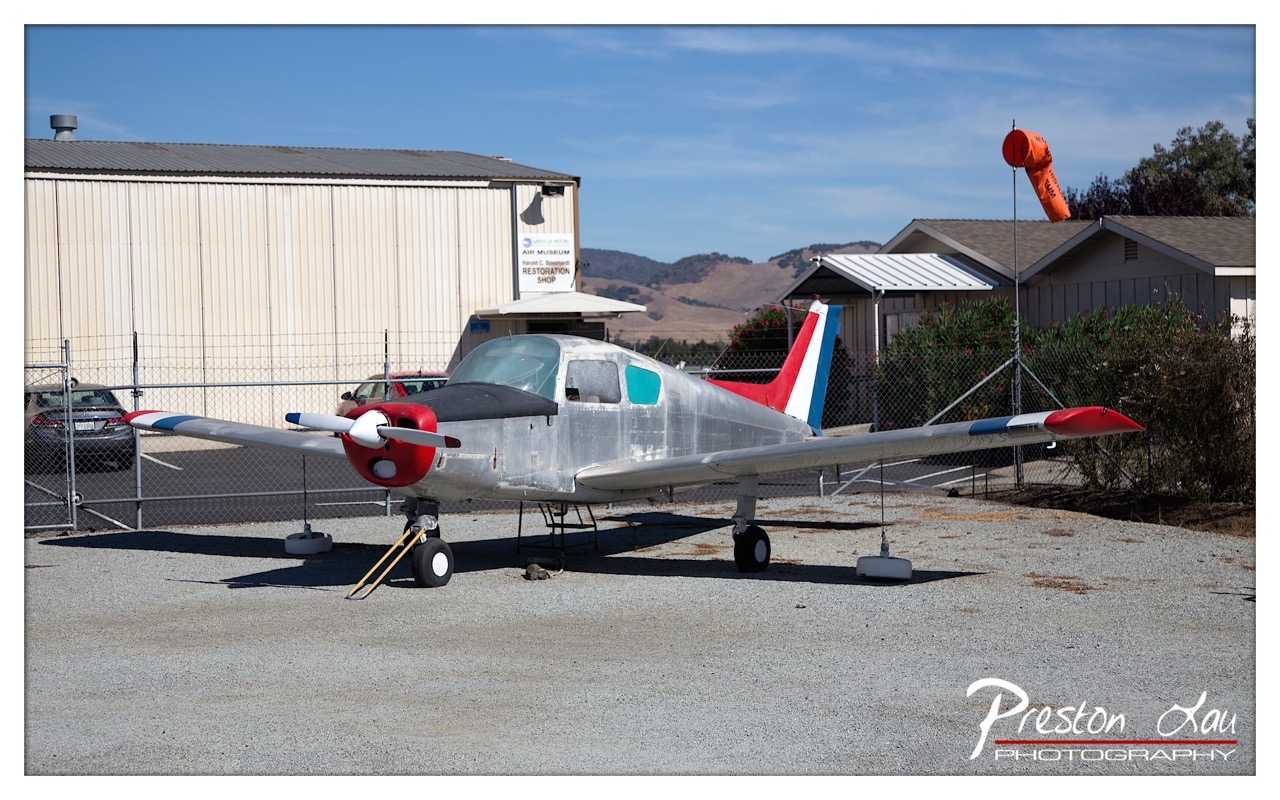

A Diamond in the Rough (Wing?)
Subject Rating: 6/10
This snapshot transports us to an airfield, likely the "Wings of History Air Museum Harold C. Rossbach Restoration Shop" based on the conveniently placed sign. Our star subject, rated a hopeful 6/10 (plenty of room for improvement!), is a small, single-engine aircraft looking decidedly unpolished, sitting patiently on the gravel ground. It appears to be in a state of undress, perhaps mid-restoration or simply weathering the elements, its bare metal fuselage reflecting the bright day. Nothing particularly action-packed is happening – it's just existing, providing a static focal point against the backdrop of corrugated metal buildings, a chain-link fence guarding some parked cars, and distant golden hills under a vast blue sky. An orange windsock atop the smaller building stands at attention, perhaps mocking the plane's grounded status, adding a pop of vibrant color to the scene's mostly earthy and metallic tones. The overall mood feels quiet and historical, hinting at past glories and future potential if that restoration ever gets finished.
From a photographer's perspective, the composition places the plane squarely in the center, which is classic but perhaps a touch predictable, especially with the fence and building forming a somewhat cluttered backdrop. The lighting screams "midday sun," providing sharp details but also harsh shadows, particularly under the nose and wing. While the bright red propeller cone and tail stripe add some much-needed visual energy, the overall color palette is dominated by the plane's matte silver and the neutral tones of the environment. The subject matter itself – a vintage plane, even one in need of TLC – is inherently interesting, appealing to niche enthusiasts. However, capturing it under softer light or from a more dynamic angle might have elevated the 'wow' factor. And let's not forget the elegant watermark in the corner, ensuring everyone knows who captured this potential restoration project in its current... charming state.
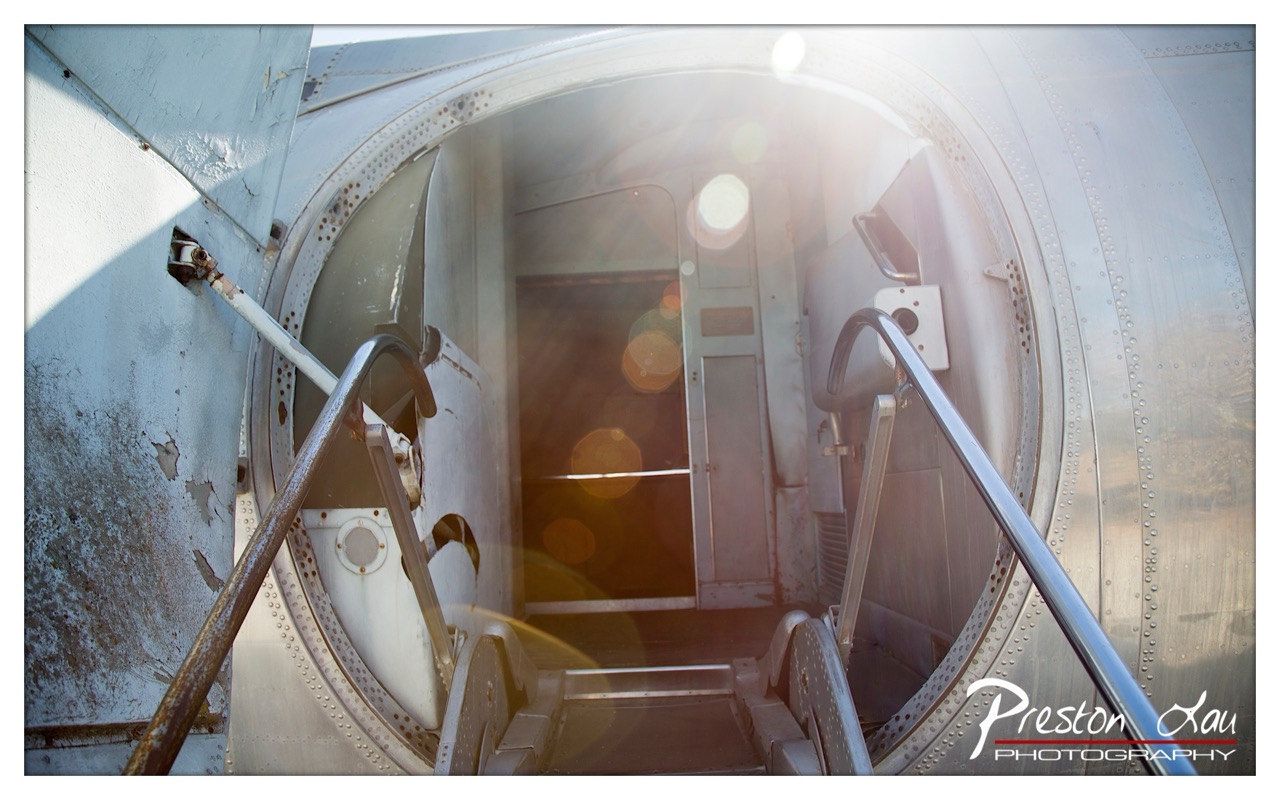

A Stairway to... Somewhere Inside This Plane
Subject Rating: 7/10
This image captures the slightly weathered and industrial entrance of an aircraft, presenting a perspective from the ground looking up the integrated stairs into the fuselage. The subject itself, a metal stairway leading into a dark opening framed by the plane's circular structure, is perhaps not conventionally stunning, but it possesses a strong sense of place and history. What's happening is simply an invitation to enter, or perhaps a view from someone exiting, though no human presence is depicted. The mood is one of quiet utility and aged resilience, hinting at countless journeys taken. Key objects include the sturdy metallic stairs, worn railings, and the heavily riveted outer skin of the aircraft. The background dissolves into a dark, ambiguous interior, adding a touch of mystery about what lies within.
From a photographic standpoint, the composition effectively uses the diagonal lines of the stairs and railings as leading lines, drawing the viewer's eye upwards into the circular frame of the doorway. The low angle emphasizes the structure and scale. The lighting is dramatic and certainly impactful; strong backlight from the sun streaming through the entrance creates intense highlights on the metal surfaces and casts deep shadows inside. While it blows out the highlights at the very top and introduces significant, somewhat distracting lens flare blobs (adding character, perhaps, or just needing a lens hood!), it undeniably shapes the image's feel. The color palette is dominated by muted, desaturated metallic greys and blues, contrasting sharply with the warm, vibrant tones of the lens flare. The textures – peeling paint, rust, polished metal, rows of rivets – are beautifully rendered, speaking to the age and function of the subject. It's a documentary-style shot elevated by the dynamic lighting, turning a mundane entrance into something visually compelling.
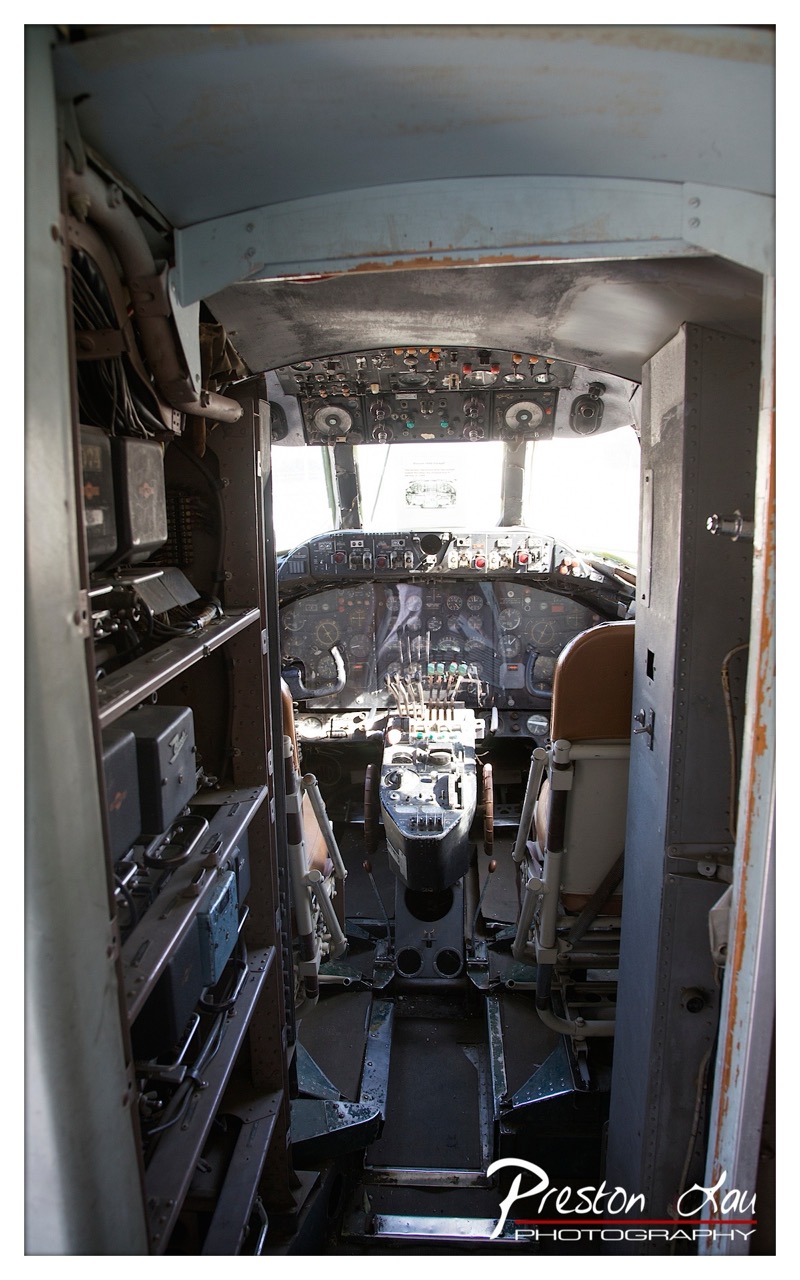

Cockpit Passage
Subject: 8/10
This image transports us down a narrow passageway into the fascinating, if somewhat cluttered, interior of an old airplane cockpit. The composition effectively leads the eye from the dark foreground shelving filled with mysterious boxes and wires, down the aisle towards the main event: the pilot and co-pilot stations. The perspective is great for capturing the depth and complexity of the space. However, the lighting from the cockpit windows is intensely bright, almost blowing out the background view entirely. While dramatic, this high contrast leaves much of the foreground in deep shadow, hiding some of the intricate details of the equipment racks on the left, prompting us to wonder what forgotten secrets they hold.
The mood is one of quiet, aged history. The worn seats, multitude of dials, levers, and the rather industrial aesthetic with exposed rivets and metalwork all speak of a bygone era of aviation. The color palette is predominantly muted greys, browns, and the slight blue tint of the overhead panels, conveying a sense of age and disuse. The subject matter is incredibly rich for anyone interested in aeronautical history, presenting a complex array of instruments and controls that look decidedly analogue and perhaps bewilderingly complex by modern standards. It's a compelling capture of a once-vital space, now frozen in time, awaiting imaginary pilots or perhaps just a good dusting.
Loading map...